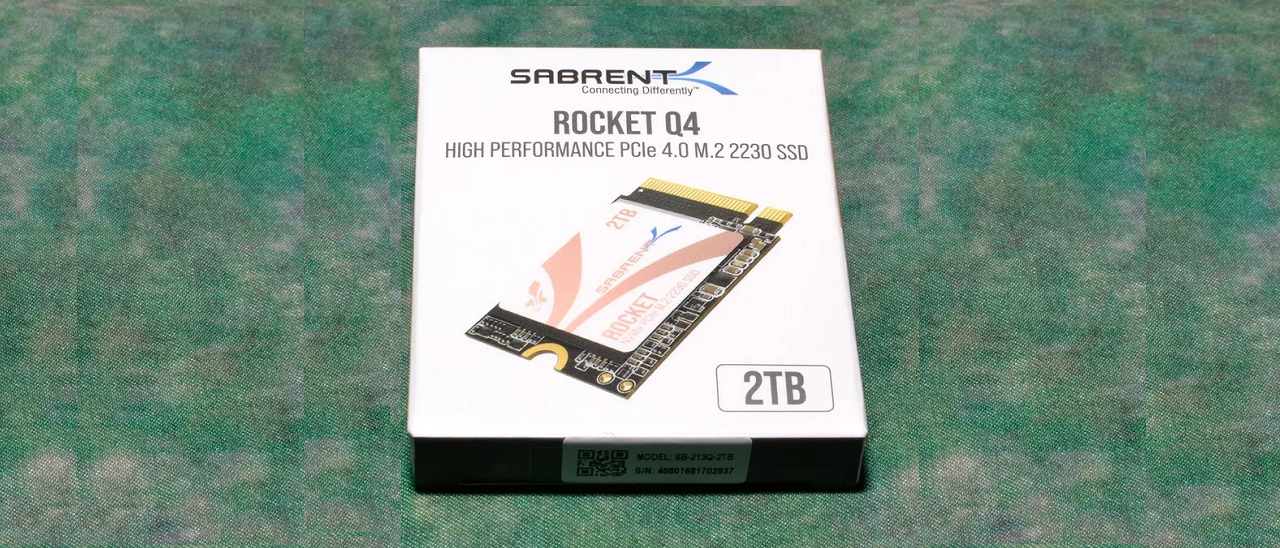Why you can trust Tom's Hardware
Comparison Products
The Sabrent Rocket Q4 2230 faces off against other M.2 2230 SSDs, including the Rocket 2230, the Corsair MP600 Mini, the older Inland TN436, the newer Inland TN446, and the Addlink S91. We also threw in a 512GB Rocket 2230 at PCIe 4.0. This gives a good range of the 2230 drives on the market, although more are to come.
The OEM SN740 and Micron 2400 options are not currently represented. Still, the former is essentially a shorter WD Black SN770, which we compared in our original Rocket 2230 review, while the 2400 is similar to a Crucial P3 Plus with the perhaps less-efficient controller found on the Solidigm P41 Plus. The P41 Plus comes in the M.2 2230 form factor, but it’s designed for OEM use.
We’d like to see an M.2 2230 drive with the InnoGrit IG5220 controller, such as the Visiontek DLX4, which we will investigate in the future. We can make some assumptions about it as we tested IG5220 SSDs like the HP FX900, which were later compared to E21T SSDs, including the Silicon Power UD90. We’ve found that the controllers should be largely comparable for 2230 devices. Still, the E21T would give a slightly better overall experience - just in case you find yourself weighing the Rocket 2230 or MP600 Mini against the DLX4 in the meantime.
Steam Deck - General
To gauge general Steam Deck performance, we engage in a variety of typical storage situations with active time measurement. These activities include dealing with the default SteamOS through initial setup, re-imaging, initial booting, and booting in general. For game testing, we see how long it takes to install and boot the popular title Hollow Knight. For a full explanation of our testing procedure, see our Steam Deck storage testing article.

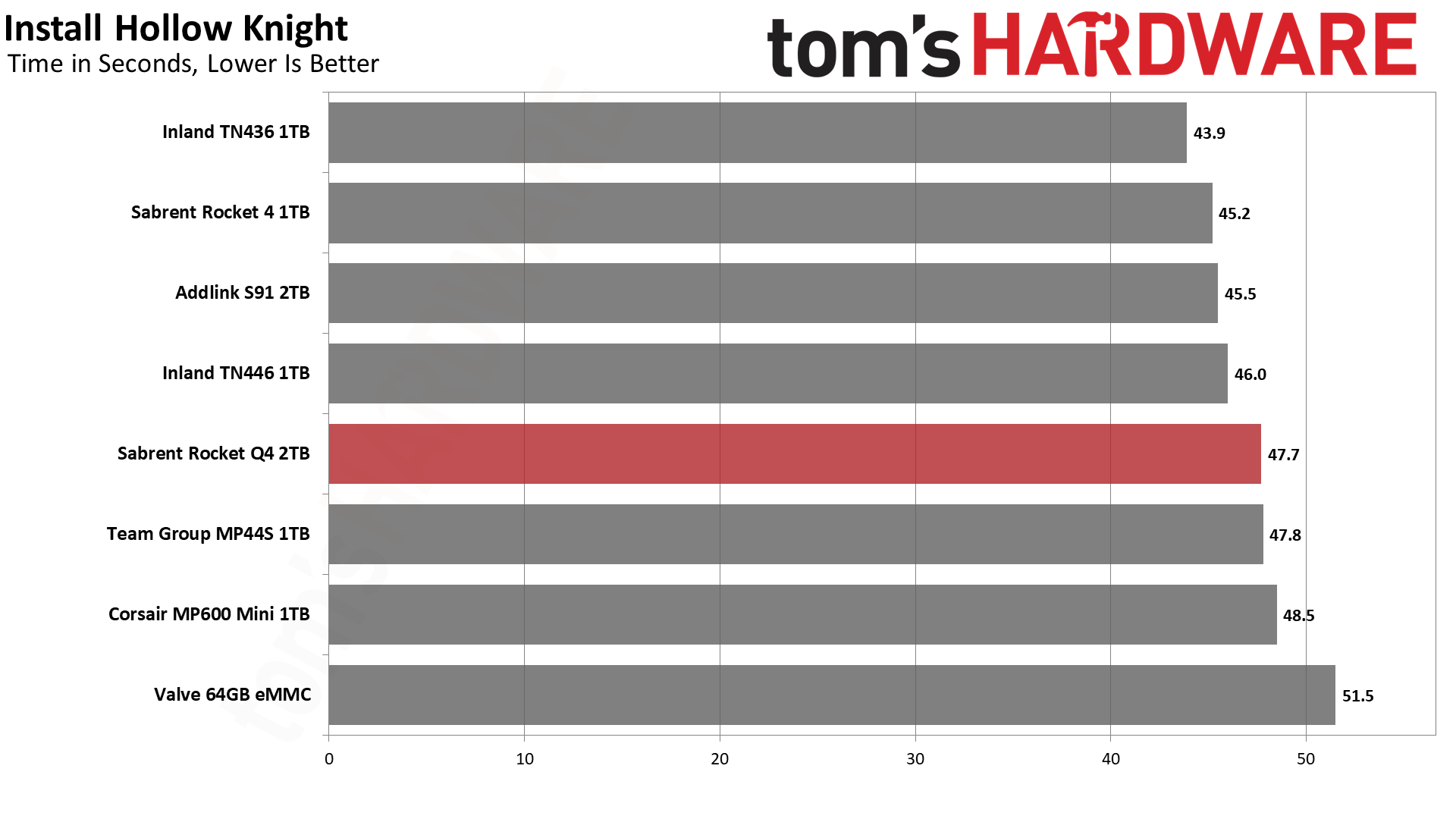
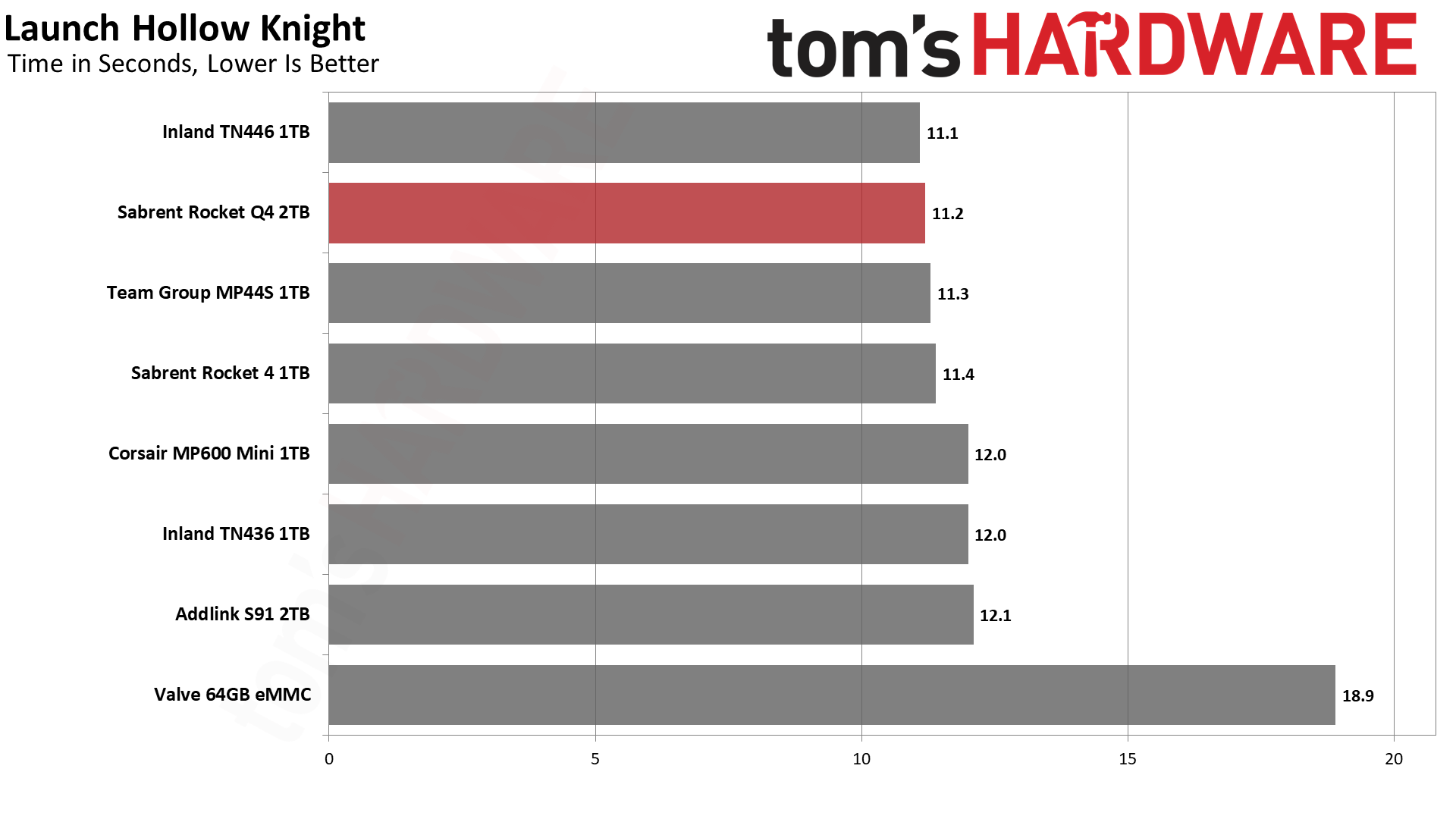
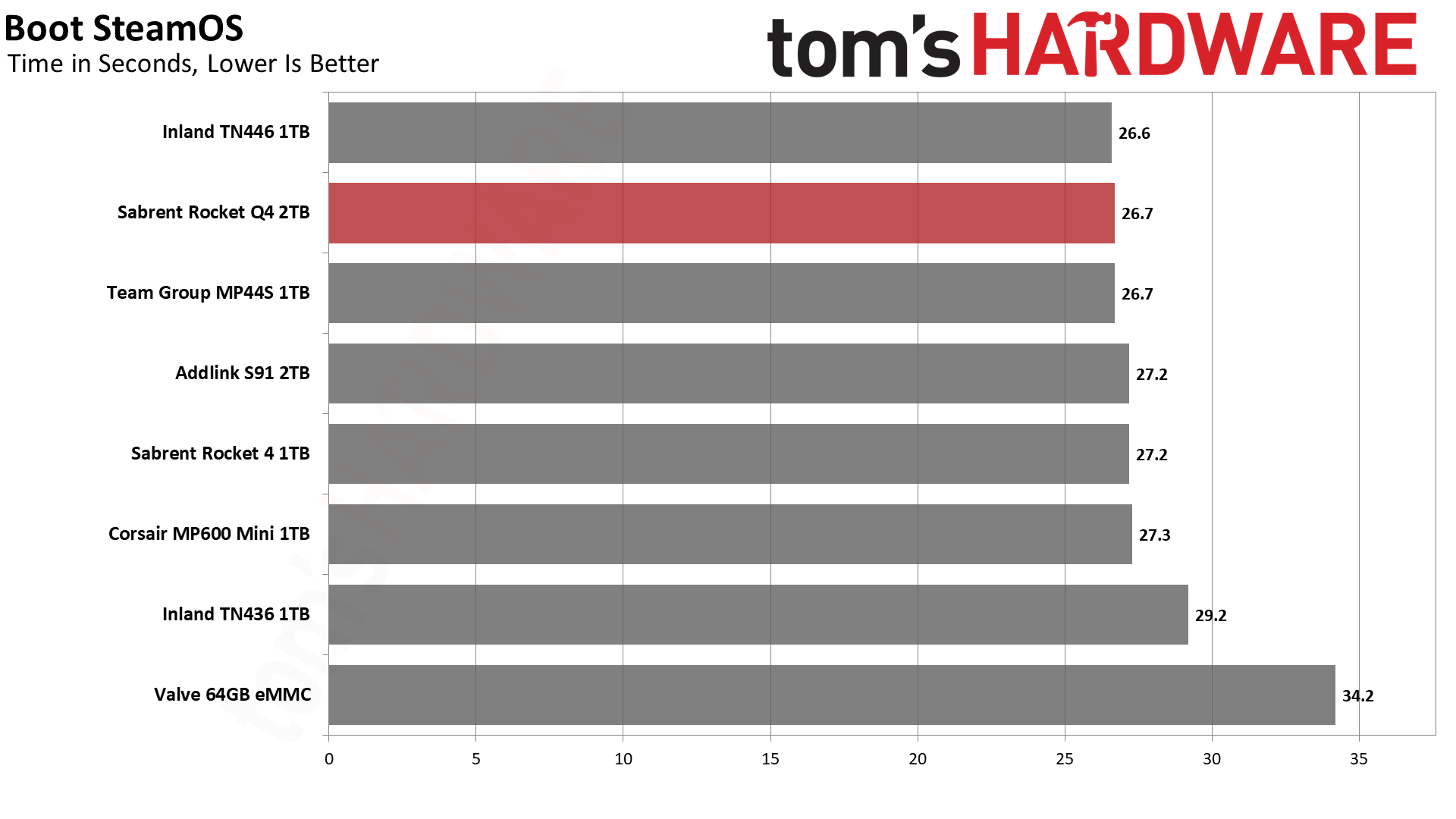
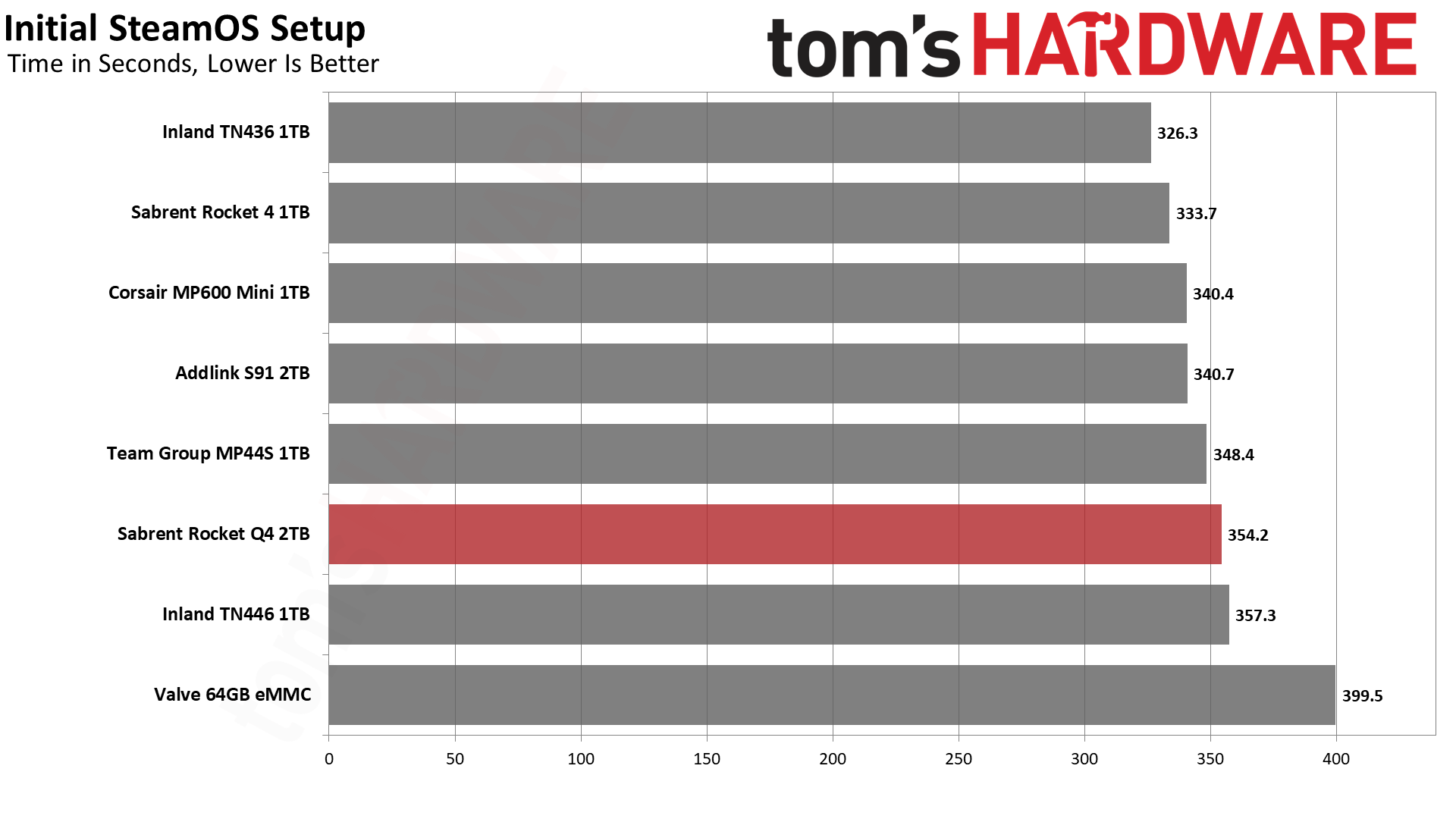

We don’t see any negative anomalies with the Rocket Q4 2230 in general Steam Deck testing. The use of QLC to reach 2TB does not appear to be a major factor when drives are restricted to PCIe 3.0 interface that's present in the Steam Deck.
Steam Deck - KDiskMark and Temperature
One of the most popular, if not the most popular, storage benchmarks is CrysalDiskMark (CDM), which we use in our own Windows-based SSD testing suite. This benchmark relies on Microsoft’s DiskSpd with templated test settings. CDM lets you quickly see how a drive performs against its idealized, rated specifications, and the benchmark can also hint at a more “real world” feel with low queue depth I/O testing.
The Linux flavor of this benchmark, which is easy to install on the Steam Deck, is KDiskMark. The “K” refers to the KDE desktop environment used on the Steam Deck. KDiskMark relies on the Flexible I/O tester, or FIO, instead of DiskSpd. For the temperature portion, we use data from the SMART sensors on the drive, which can be directly polled and from which the maximum temperature can be extracted.
Get Tom's Hardware's best news and in-depth reviews, straight to your inbox.


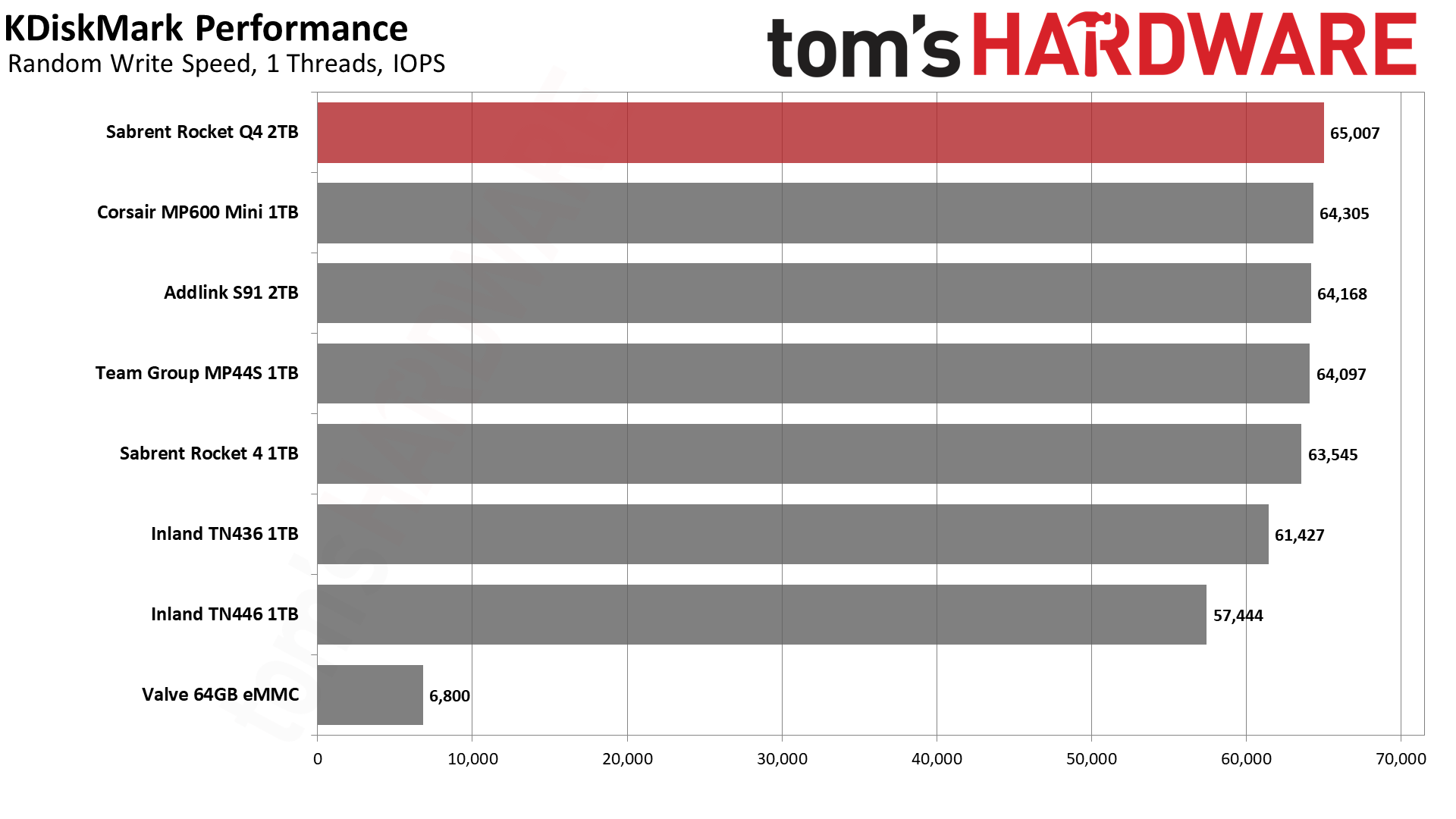

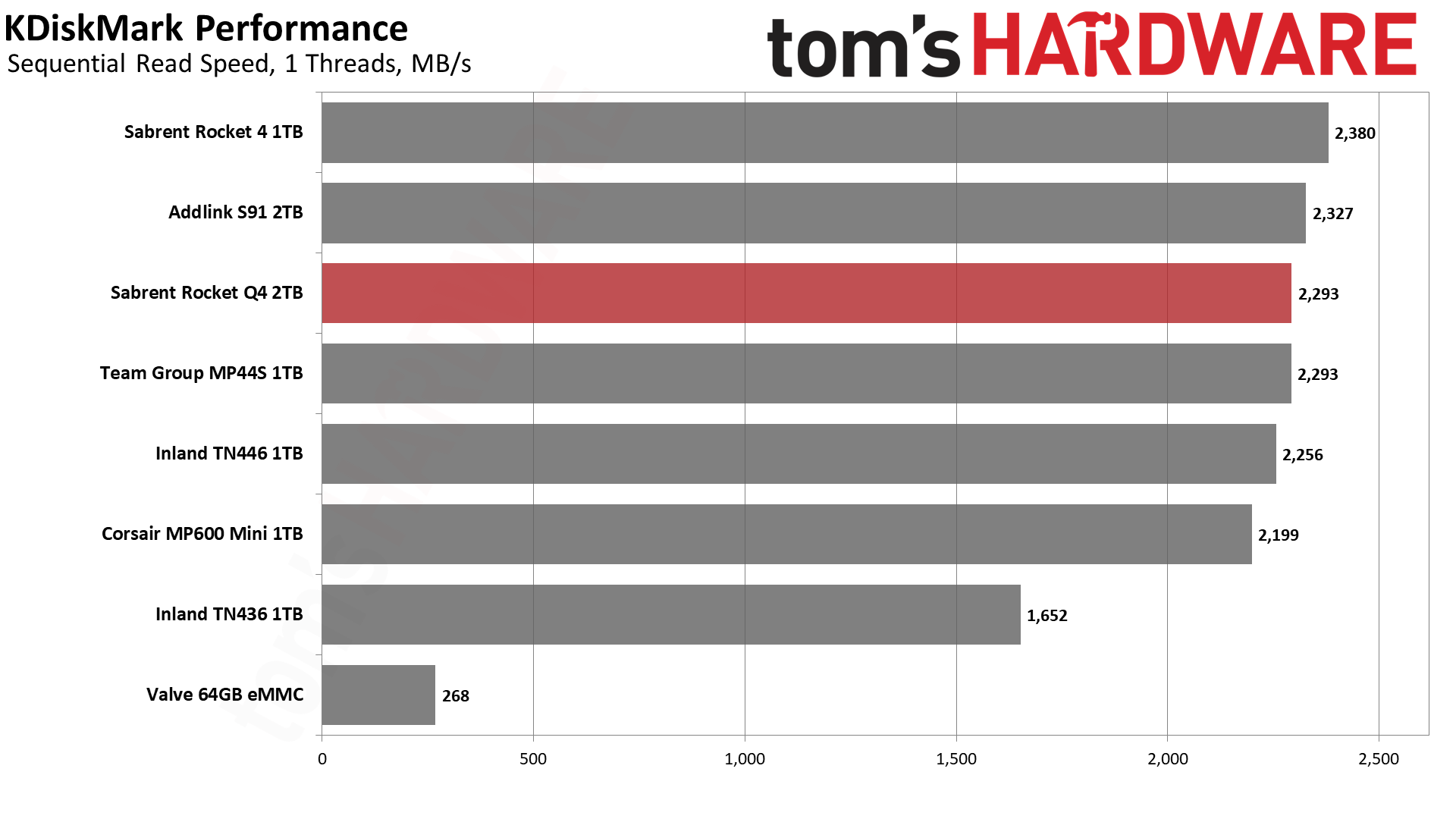
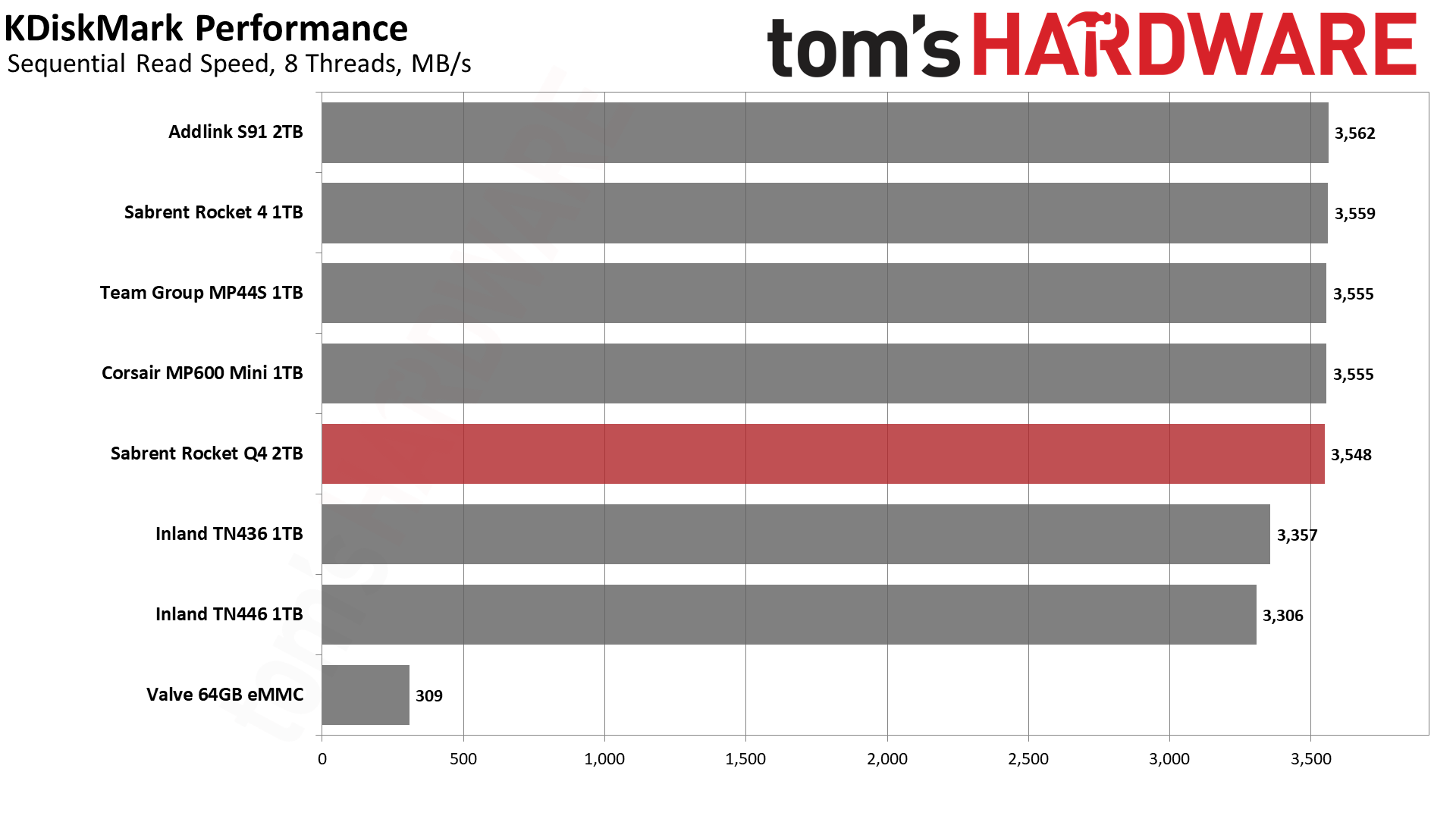
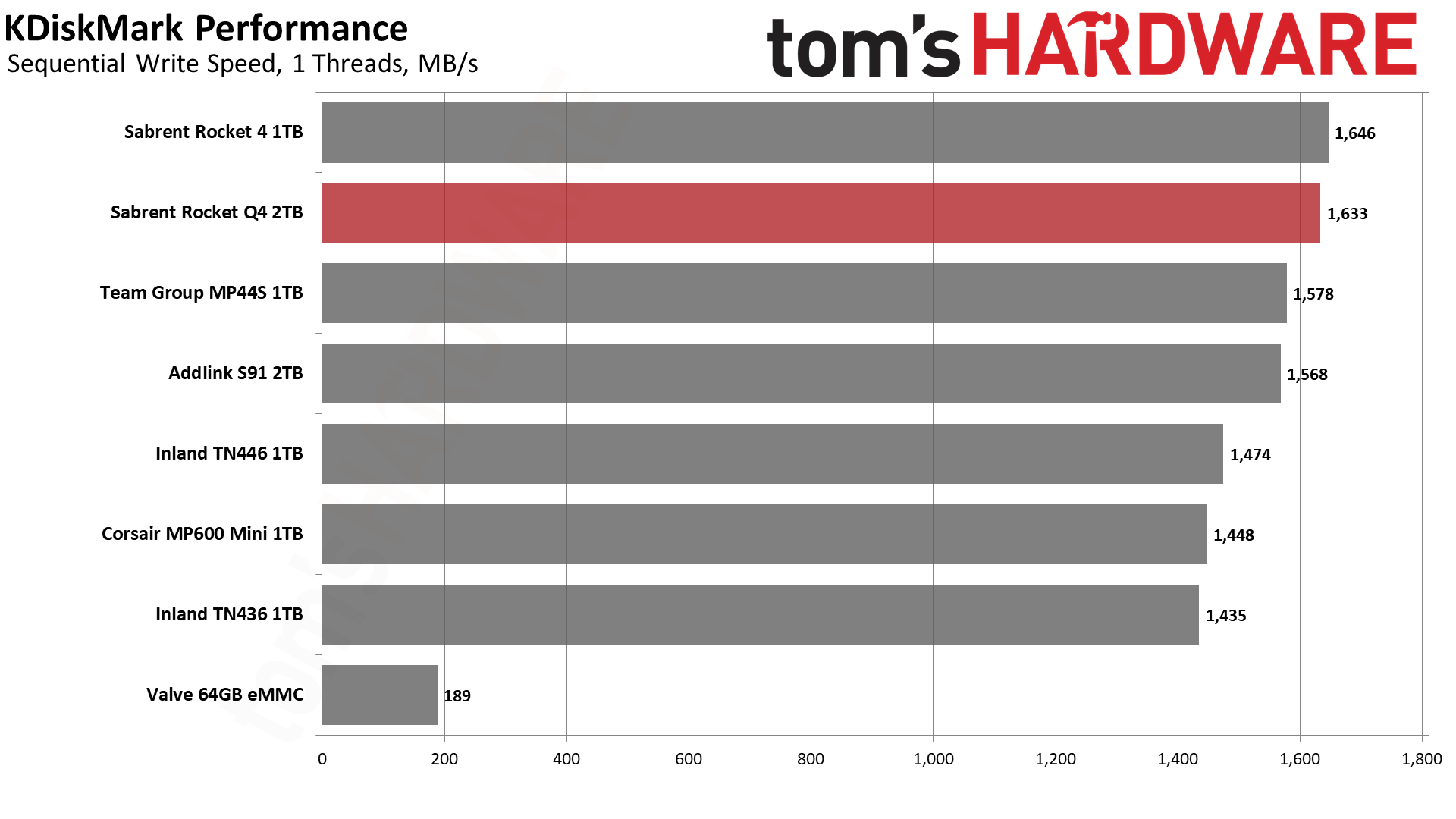
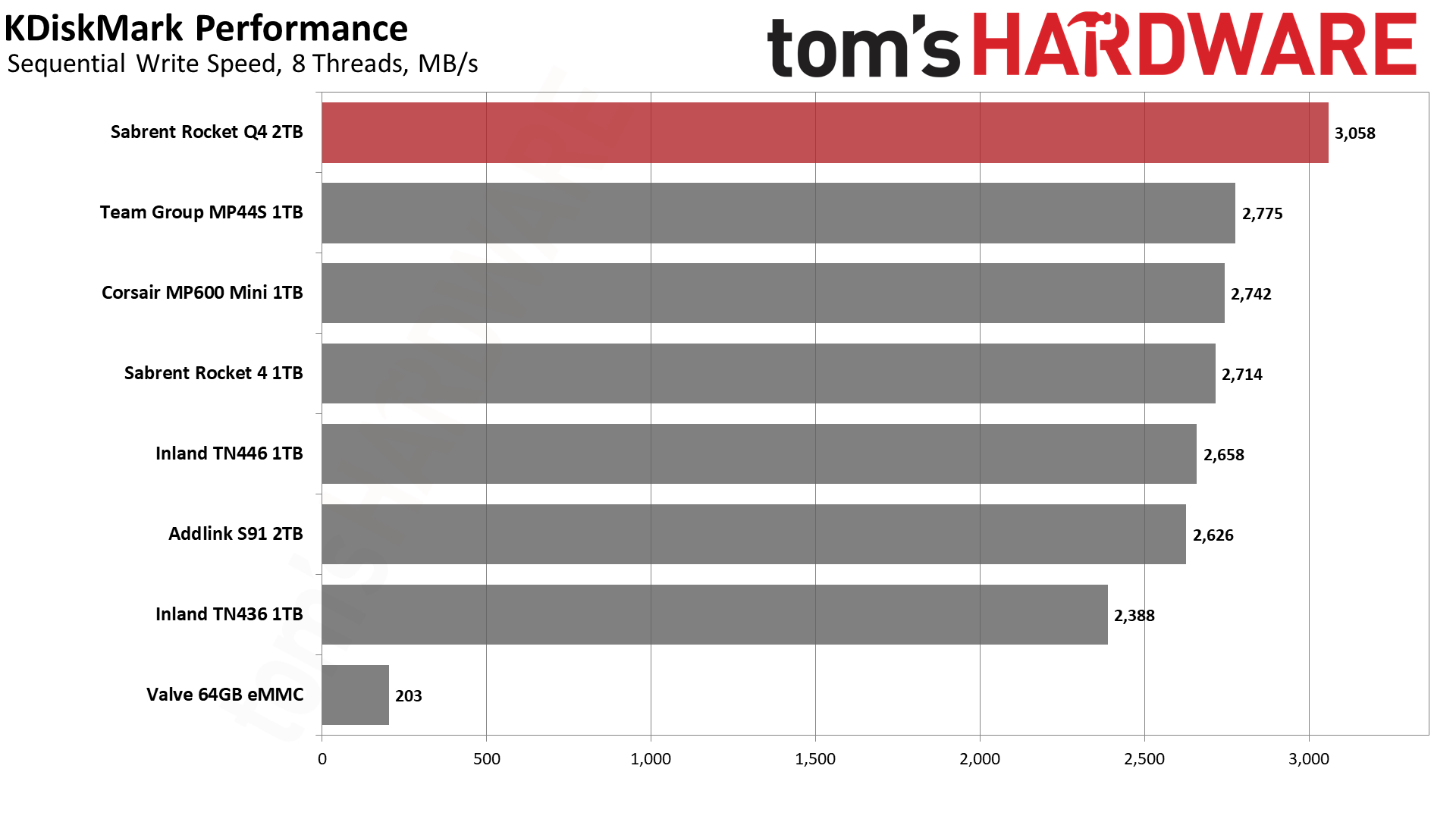
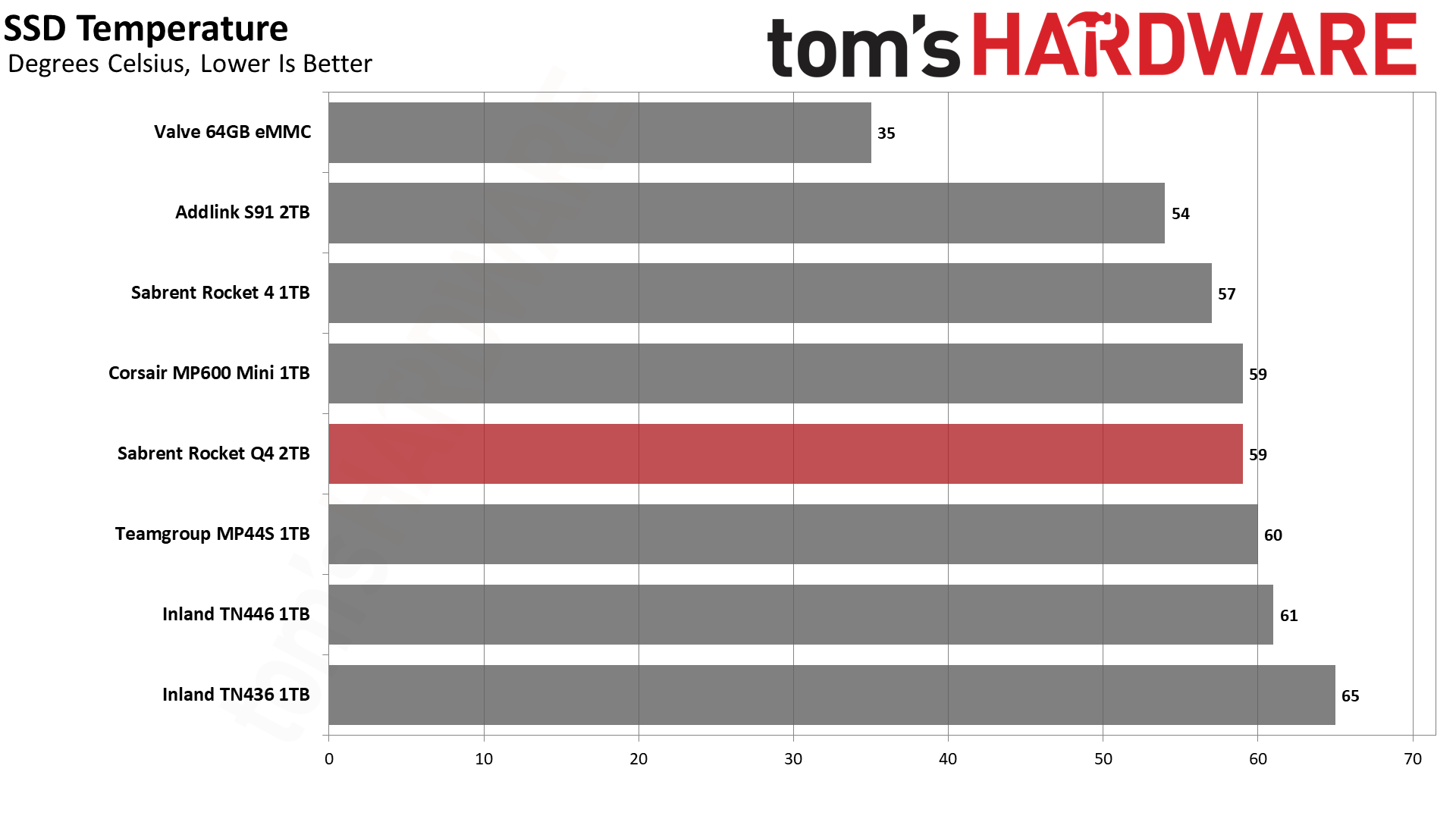
The QLC drives — the Rocket Q4 2230, the S91, and the MP44S — drop a bit in random read workloads at low queue depth. This did not translate to significantly worse general usage results for us but could impact certain games or activities to a small degree. The older TLC-based TN436 was even worse here but still far better than the stock 64GB drive.
The Q4 2230 did not run particularly cool but was within the general ballpark of other Phison E21T-based drives, whether they use TLC or QLC. We can recommend any of them for the Steam Deck.
PC Trace Testing - 3DMark Gaming Storage Benchmark
Built for gamers, 3DMark’s Storage Benchmark focuses on real-world gaming performance. Each round in this benchmark stresses storage based on gaming activities including loading games, saving progress, installing game files, and recording gameplay video streams.


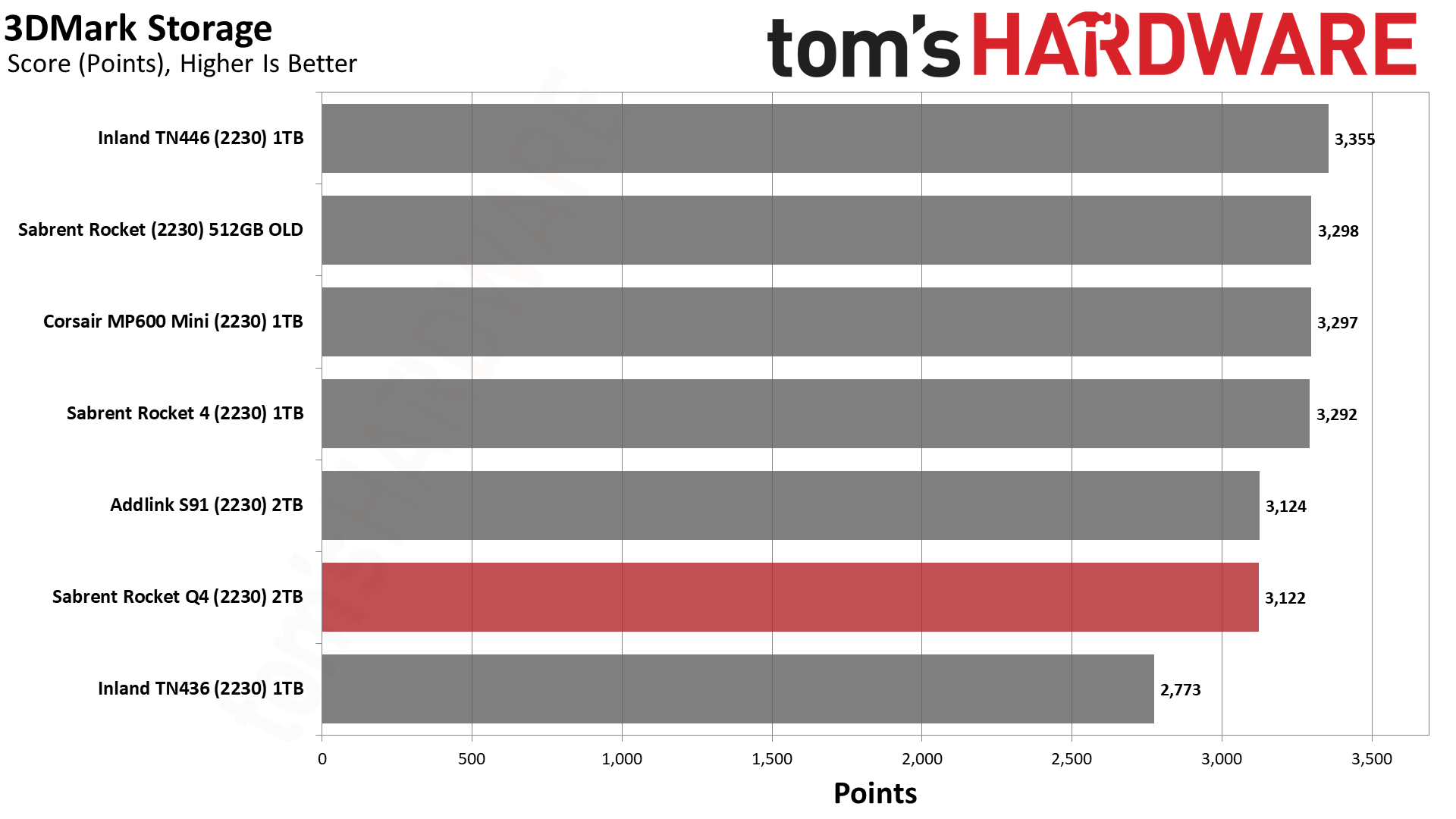



The Rocket Q4 2230 is mediocre to below average in 3DMark, falling behind the newer TLC drives. However, the difference isn't huge. Latencies are better/lower with all drives when run at PCIe 4.0 due to the controllers opening up a faster bus.
PC Trace Testing – PCMark 10 Storage Benchmark
PCMark 10 is a trace-based benchmark that uses a wide-ranging set of real-world traces from popular applications and everyday tasks to measure the performance of storage devices.


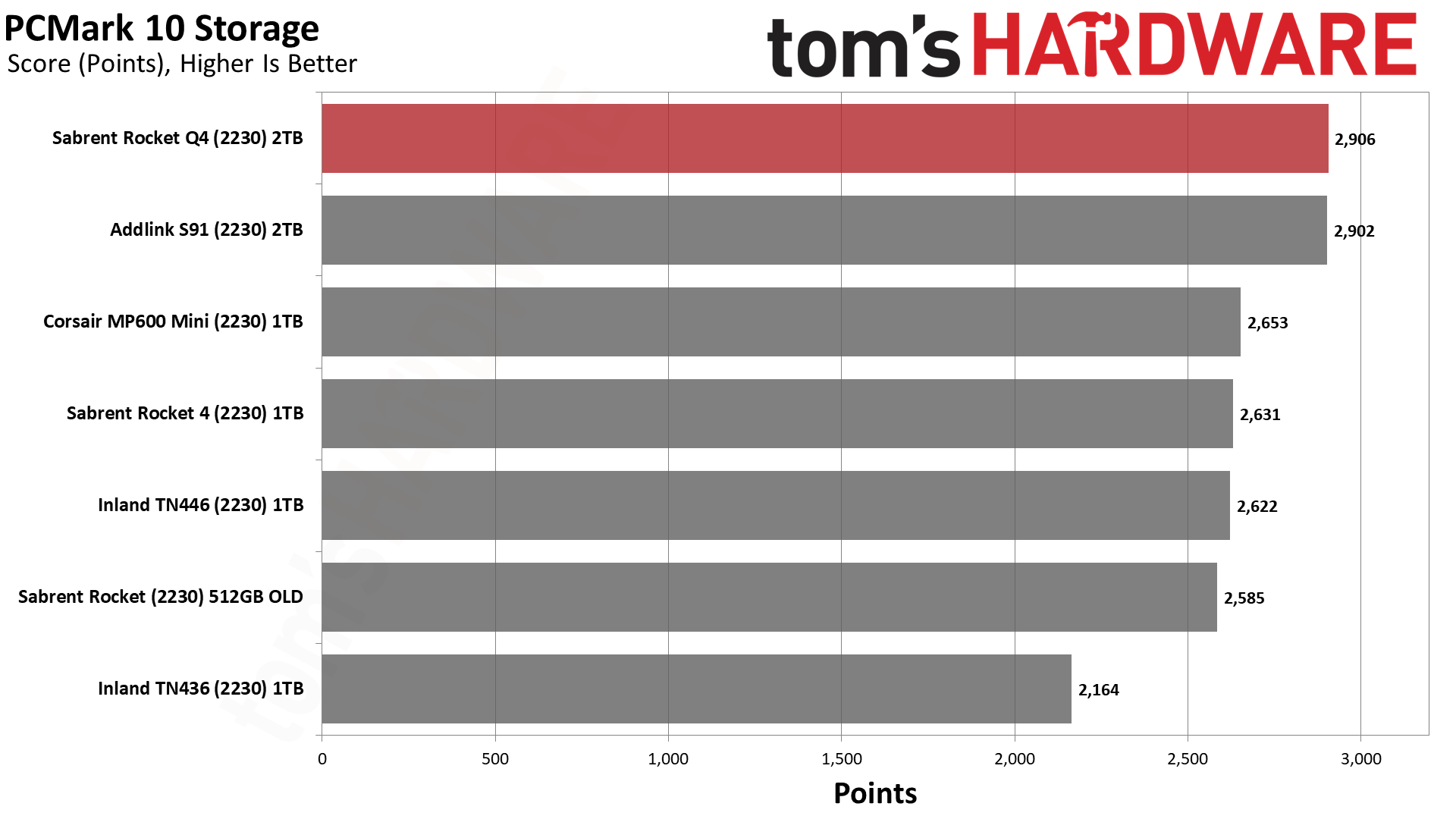

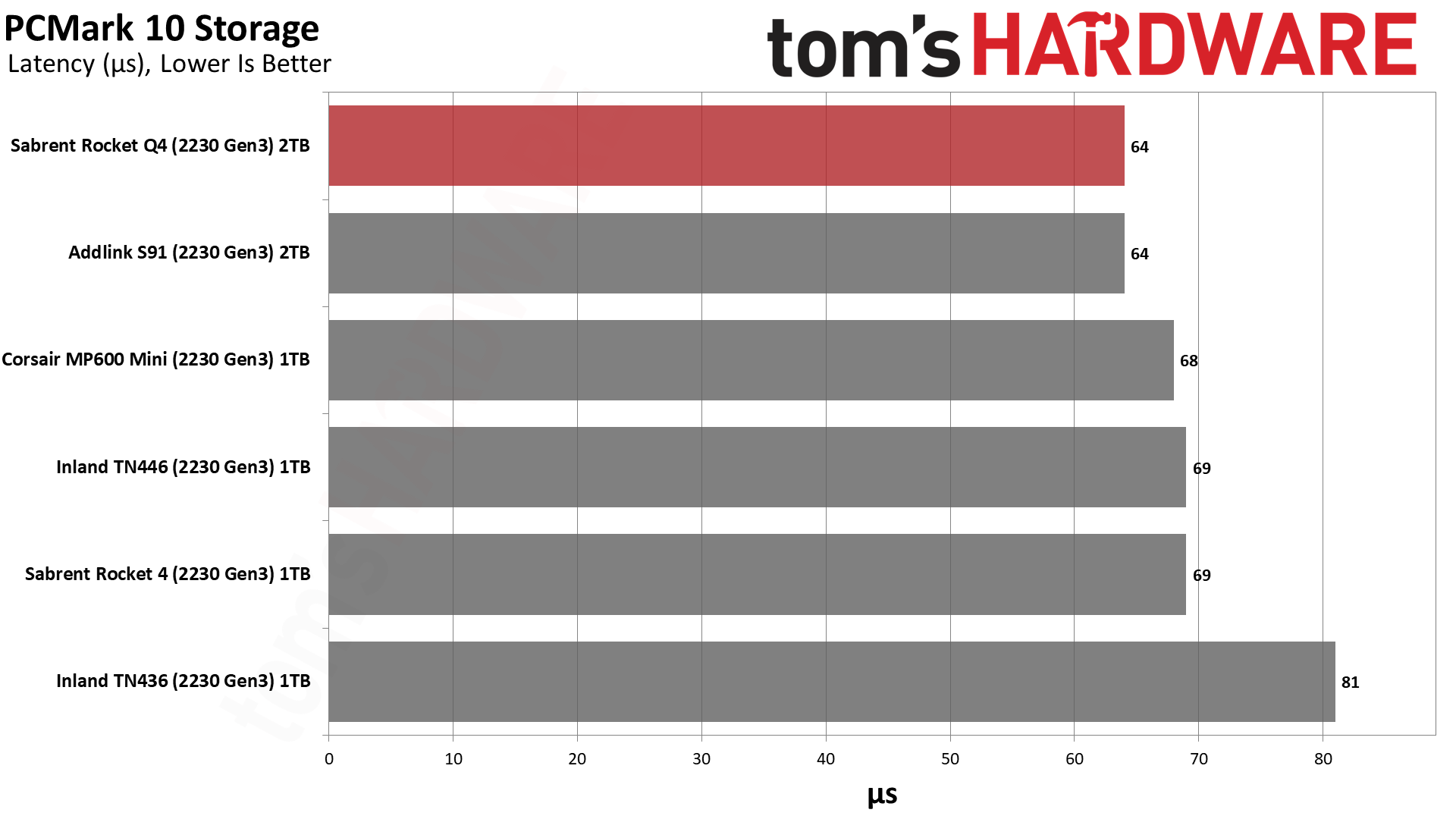

The Rocket Q4 2230 rockets ahead to first place, followed by the very similar S91. This is a matter of capacity, as these are the two 2TB drives. Latencies are again better with a PCIe 4.0 interface, although the difference between the Deck and ROG Ally with these drives may more likely come from the OS being used.
It isn’t easy to guess what a 2TB TLC drive would look like here, but a possible example is the Addlink S90 Lite, which utilizes the same E21T controller. Its performance is within the ballpark of what we get with QLC. This is likely a limitation of the less-dense TLC and would be overcome when using 1Tb TLC. The 2TB SN770, which should score like the 2TB SN740, has results that support this theory. Future drives with Micron’s 232-Layer TLC would also probably score better.
PC Transfer Rates – DiskBench
We use the DiskBench storage benchmarking tool to test file transfer performance with a custom, 50GB dataset. We copy 31,227 files of various types, such as pictures, PDFs, and videos to a new folder and then follow-up with a reading test of a newly-written 6.5GB zip file.
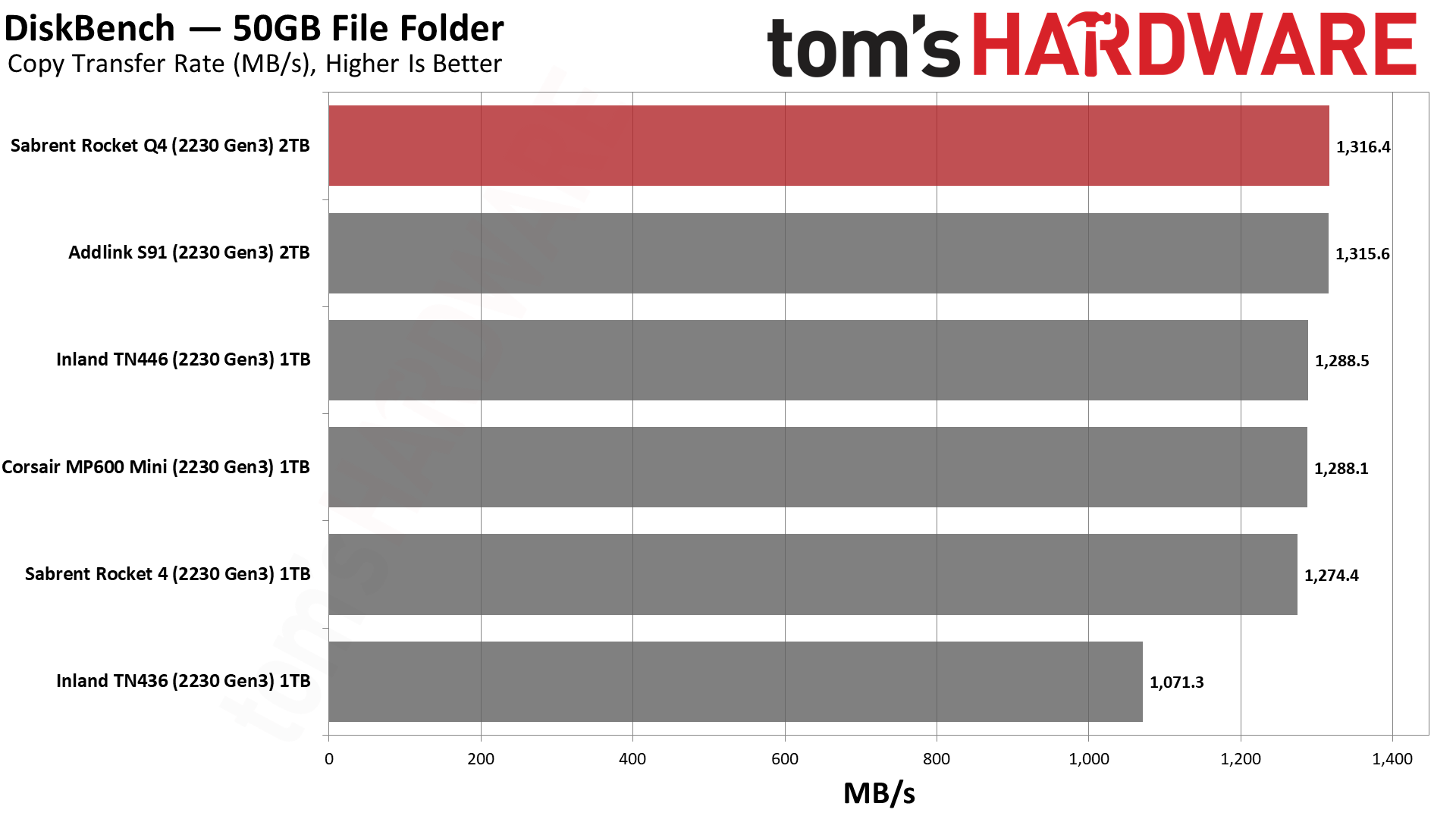
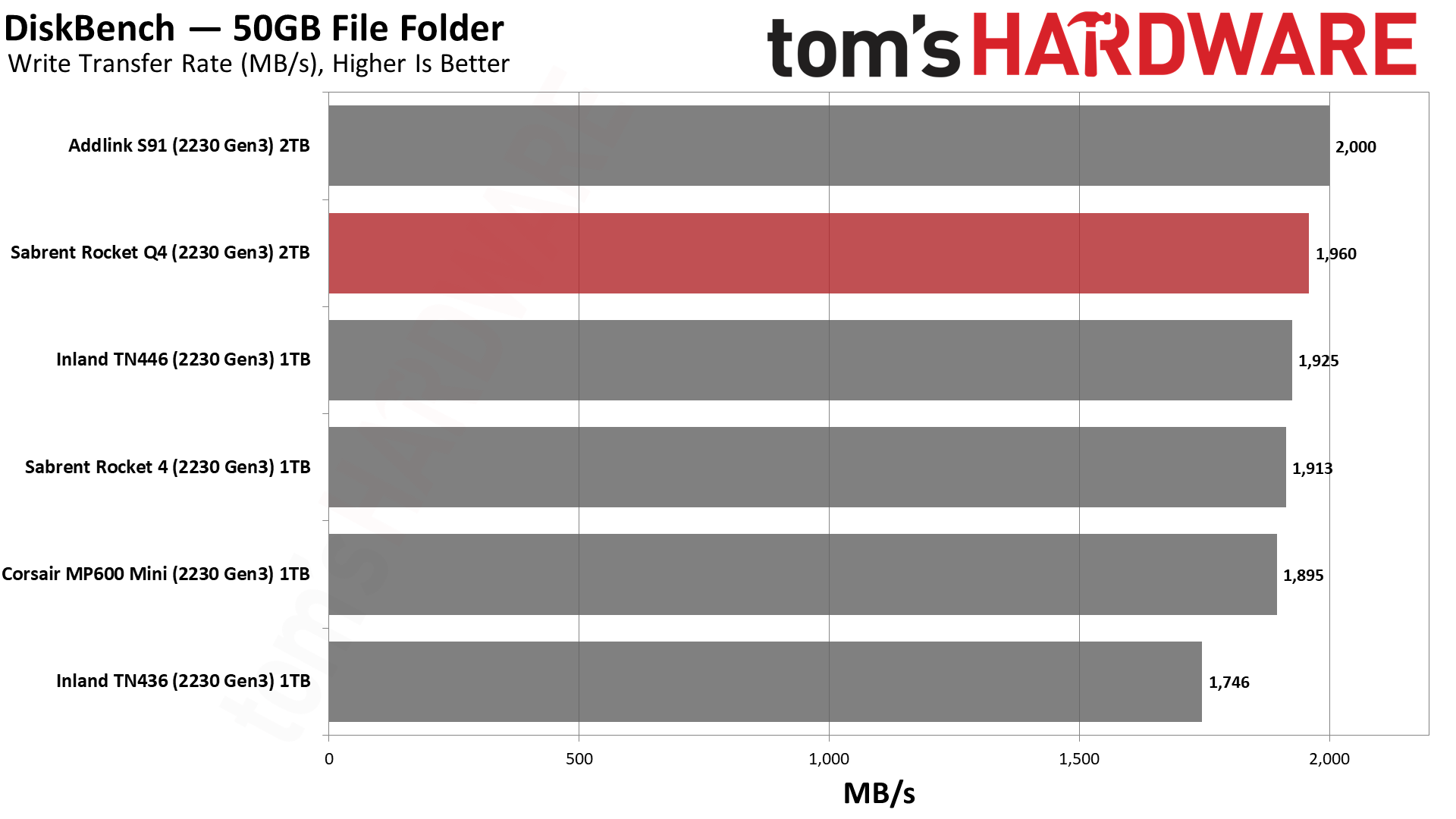


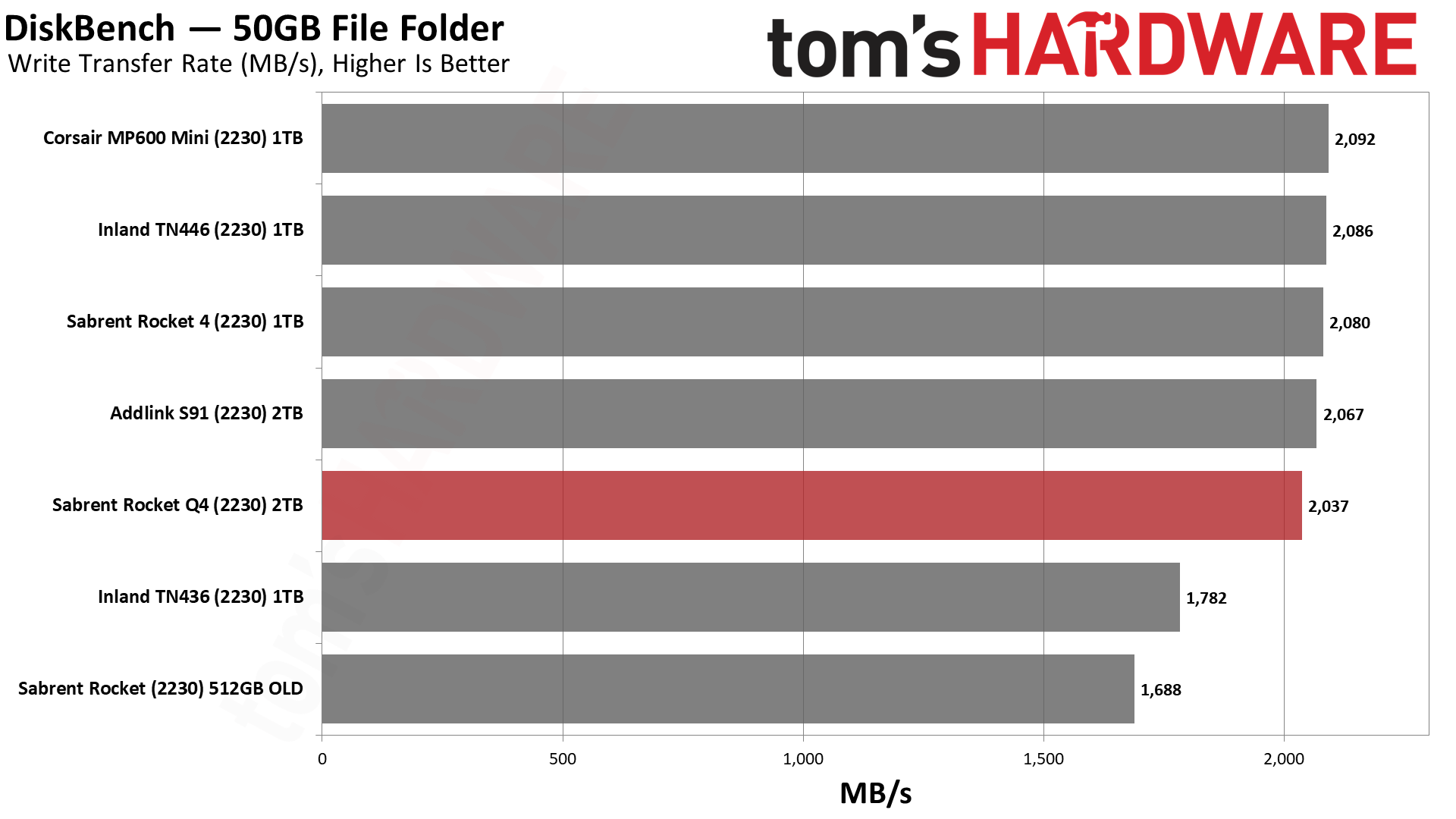

Copying requires writing, so the QLC drives, like the Rocket Q4 2230, are bound to fall behind in DiskBench. None of these drives can saturate the PCIe 4.0 interface, and being so close to the PCIe 3.0 edge means the Q4 2230 doesn’t gain much here by using the faster interface. This is bittersweet as it does mean the drive doesn’t lose much when used in the PCIe 3.0 Steam Deck. It has more dies than the 512GB Rocket 2230, so it can also benefit from its extra capacity, which is a factor for those upgrading from ≤512GB stock drives.
PC Synthetic Testing - ATTO / CrystalDiskMark
ATTO and CrystalDiskMark (CDM) are free and easy-to-use storage benchmarking tools that SSD vendors commonly use to assign performance specifications to their products. Both of these tools give us insight into how each device handles different file sizes.
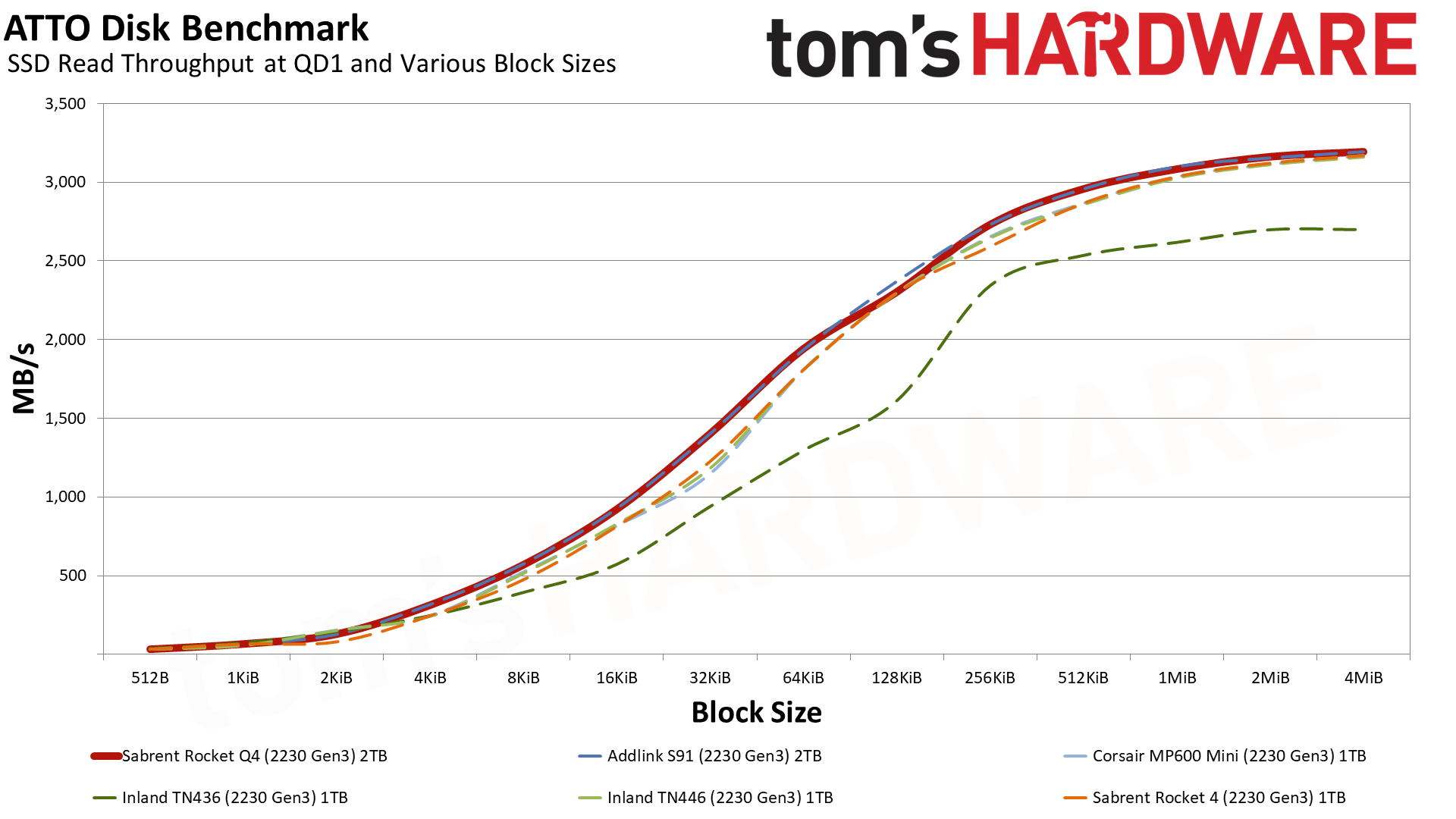



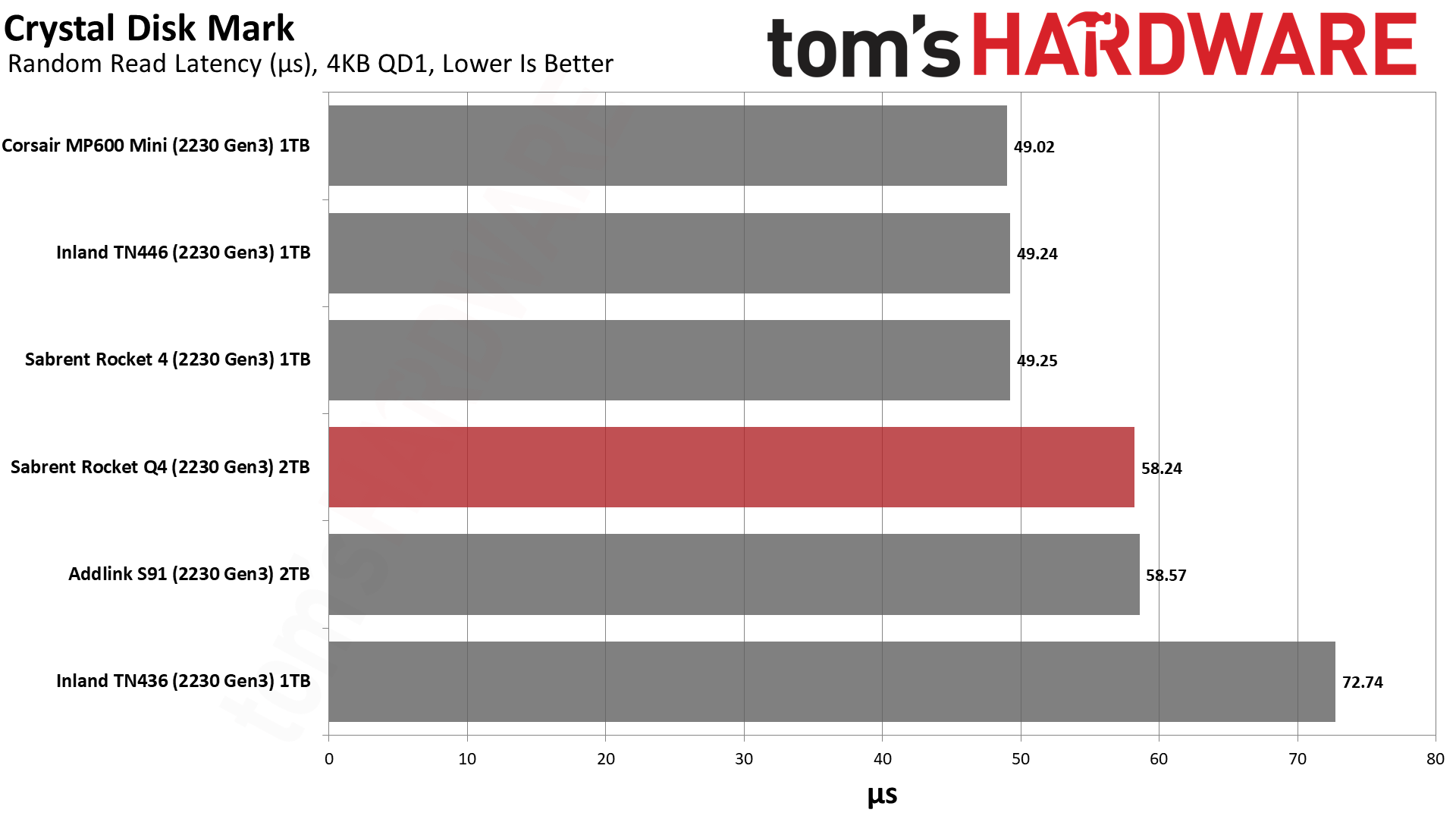


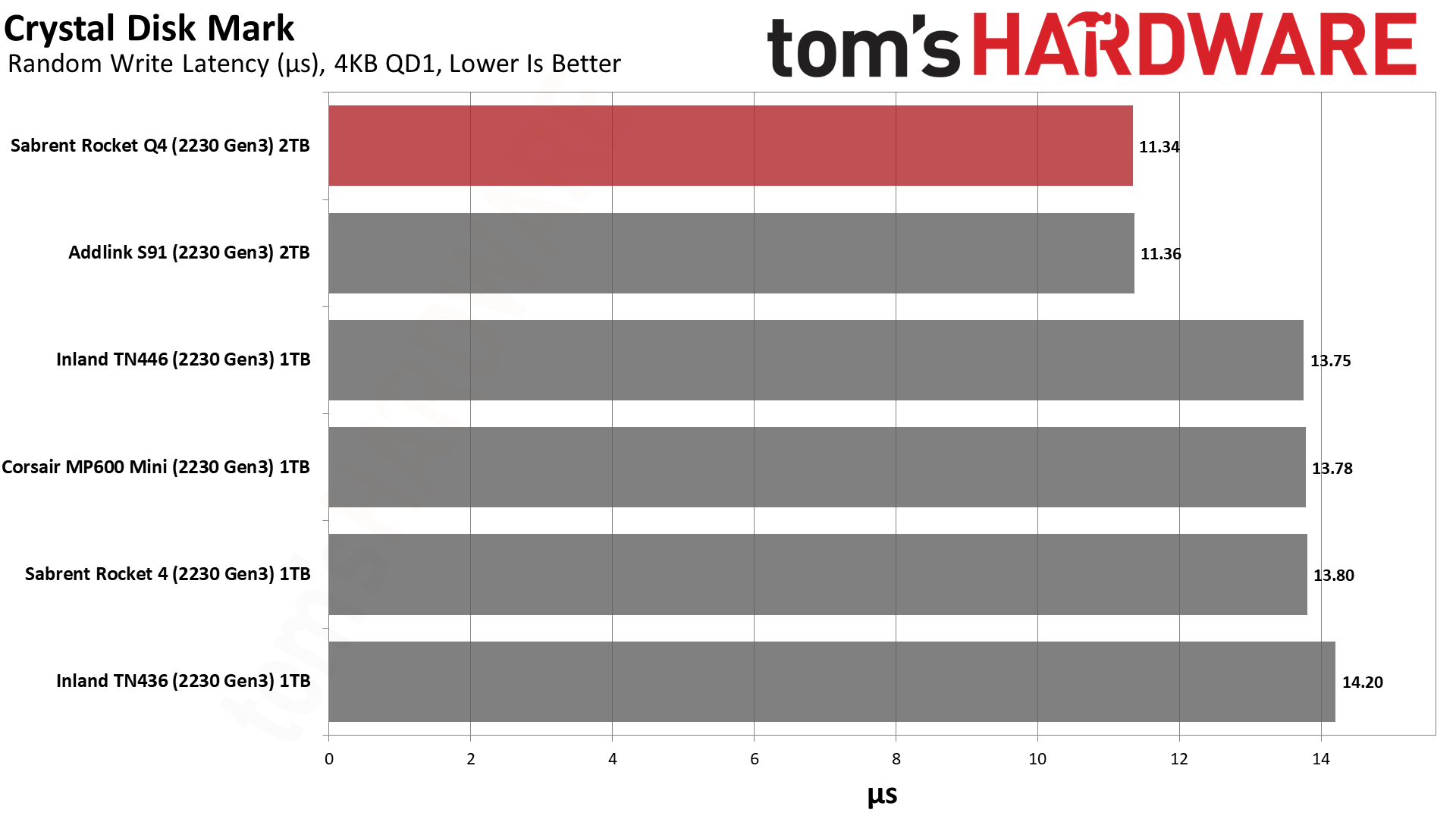
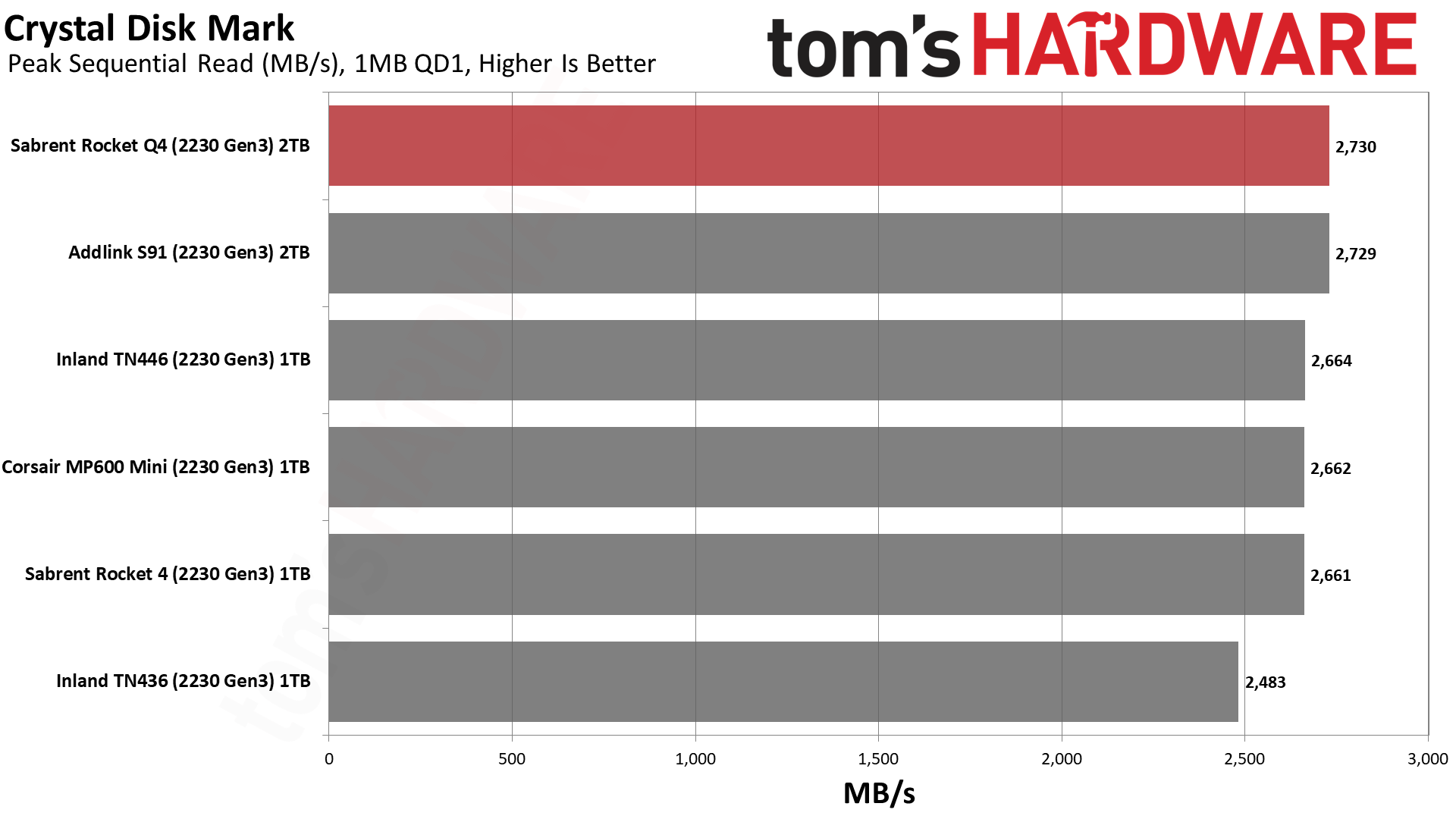
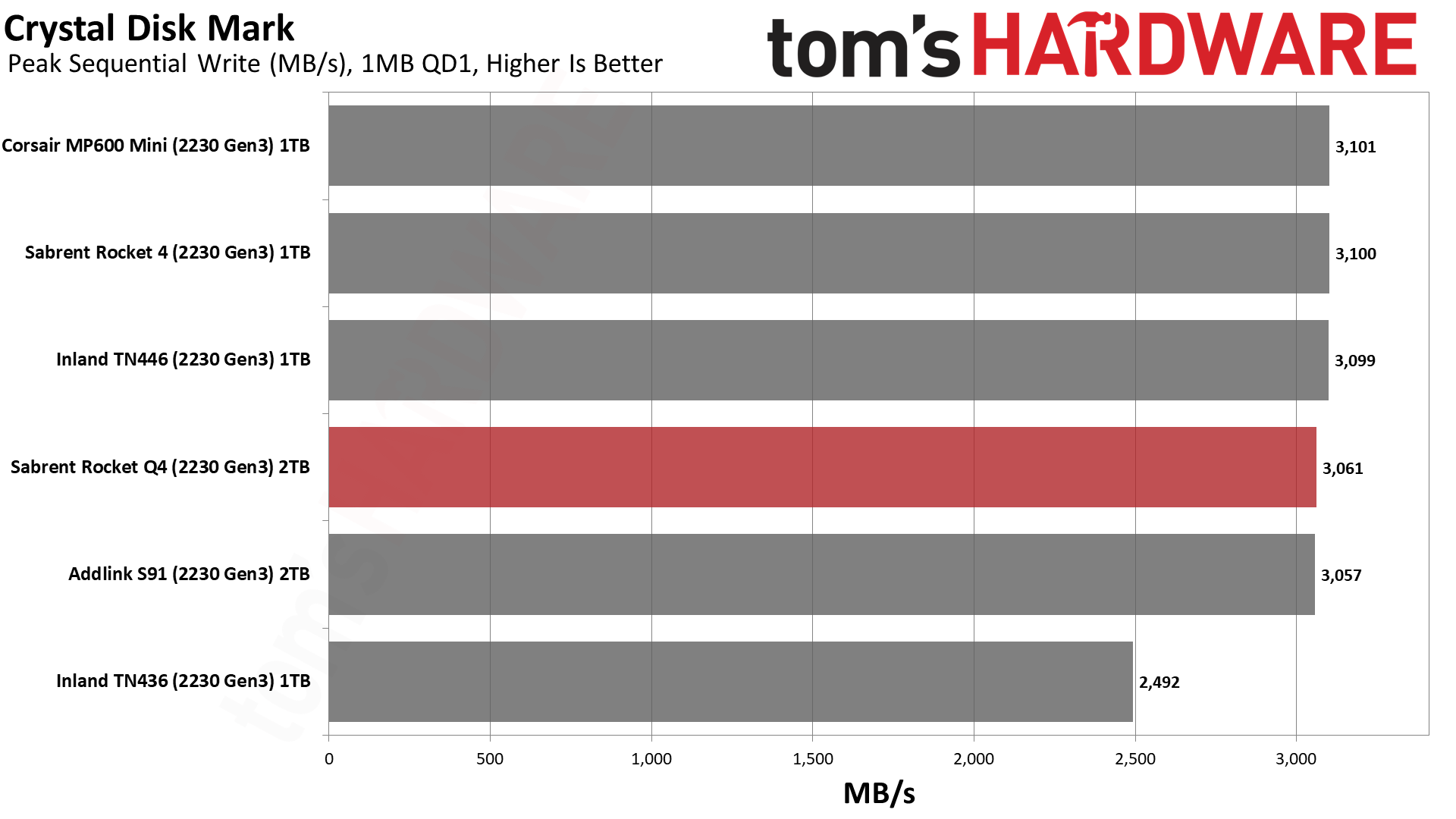
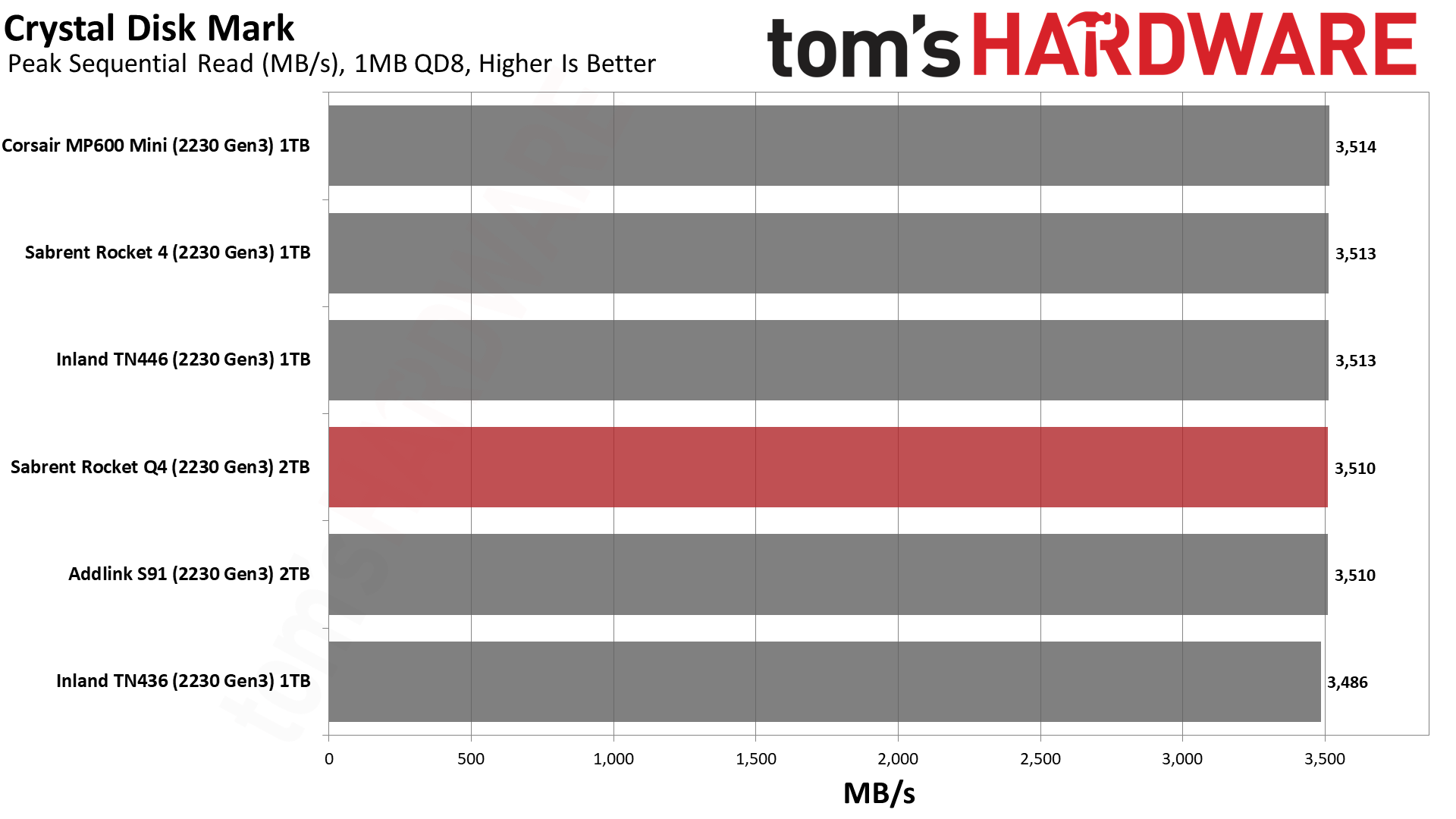


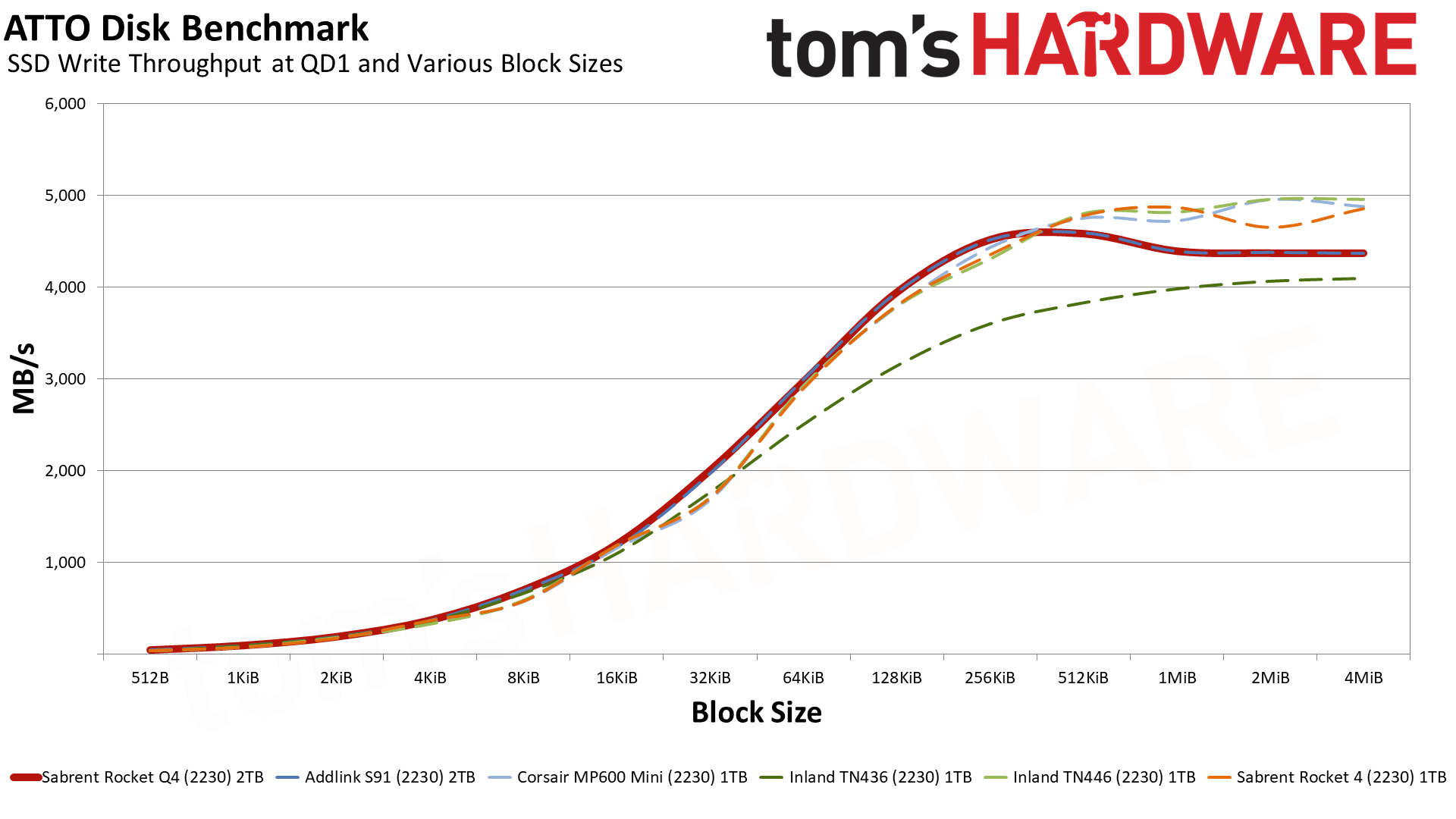
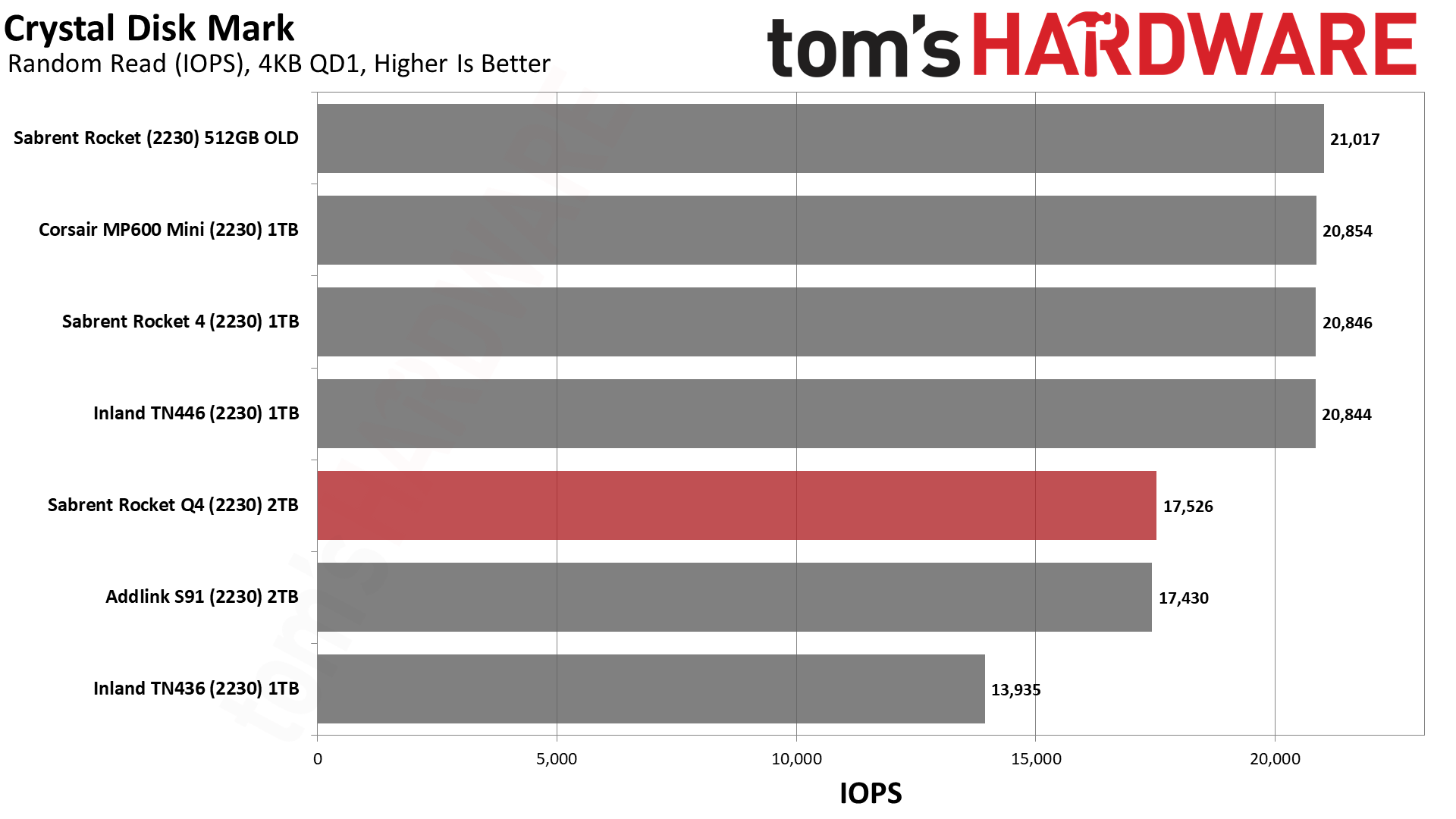
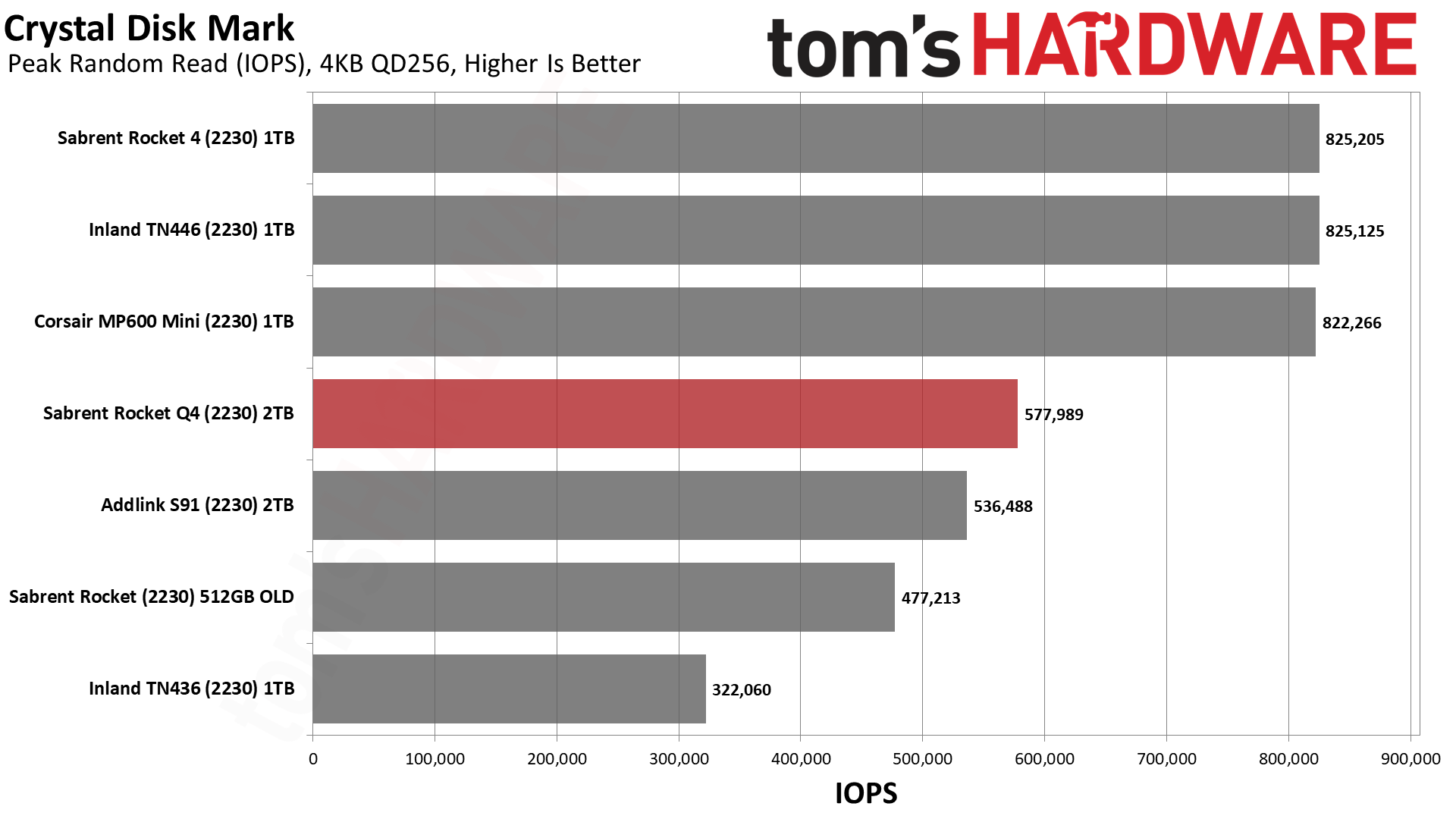
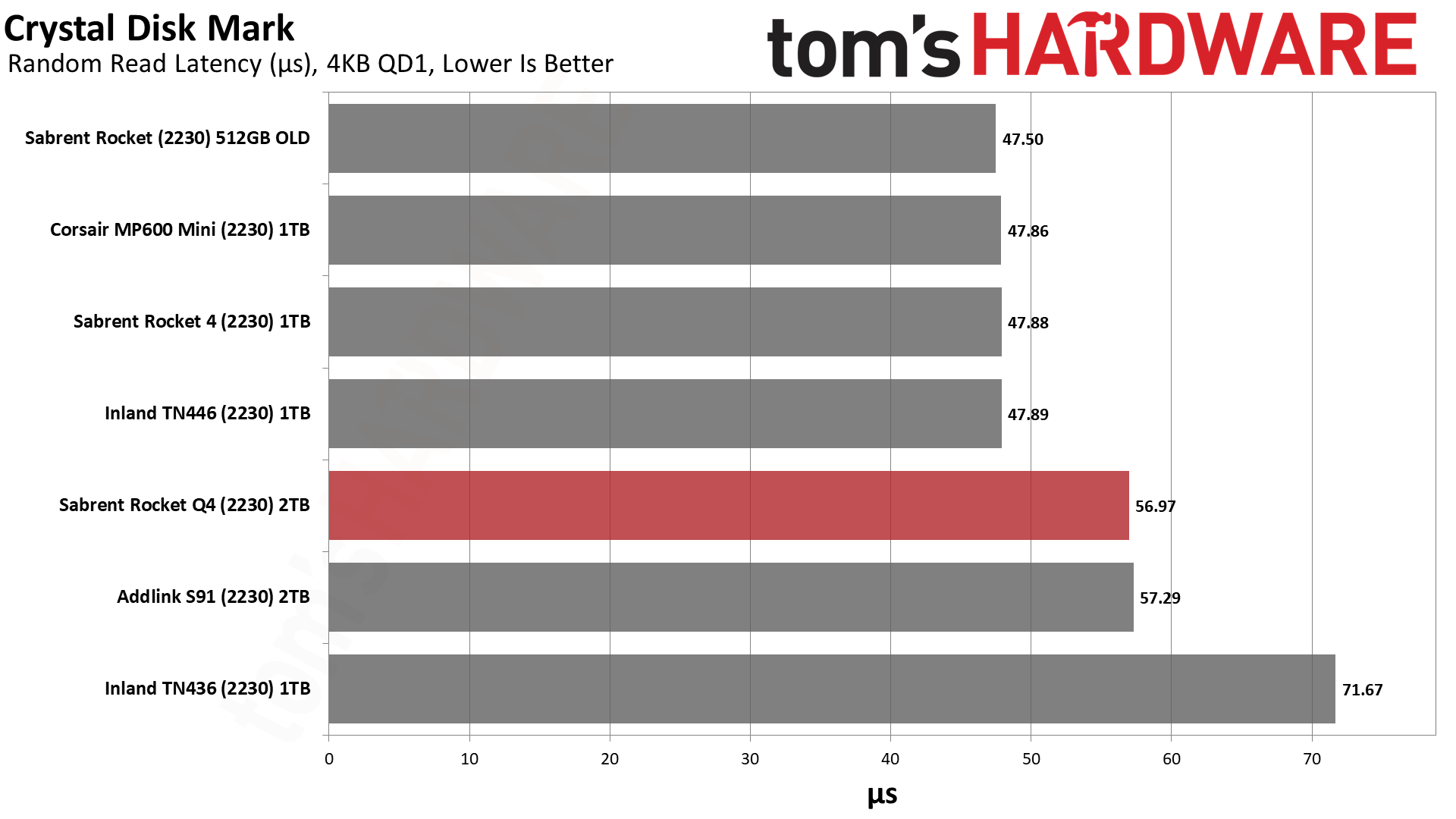
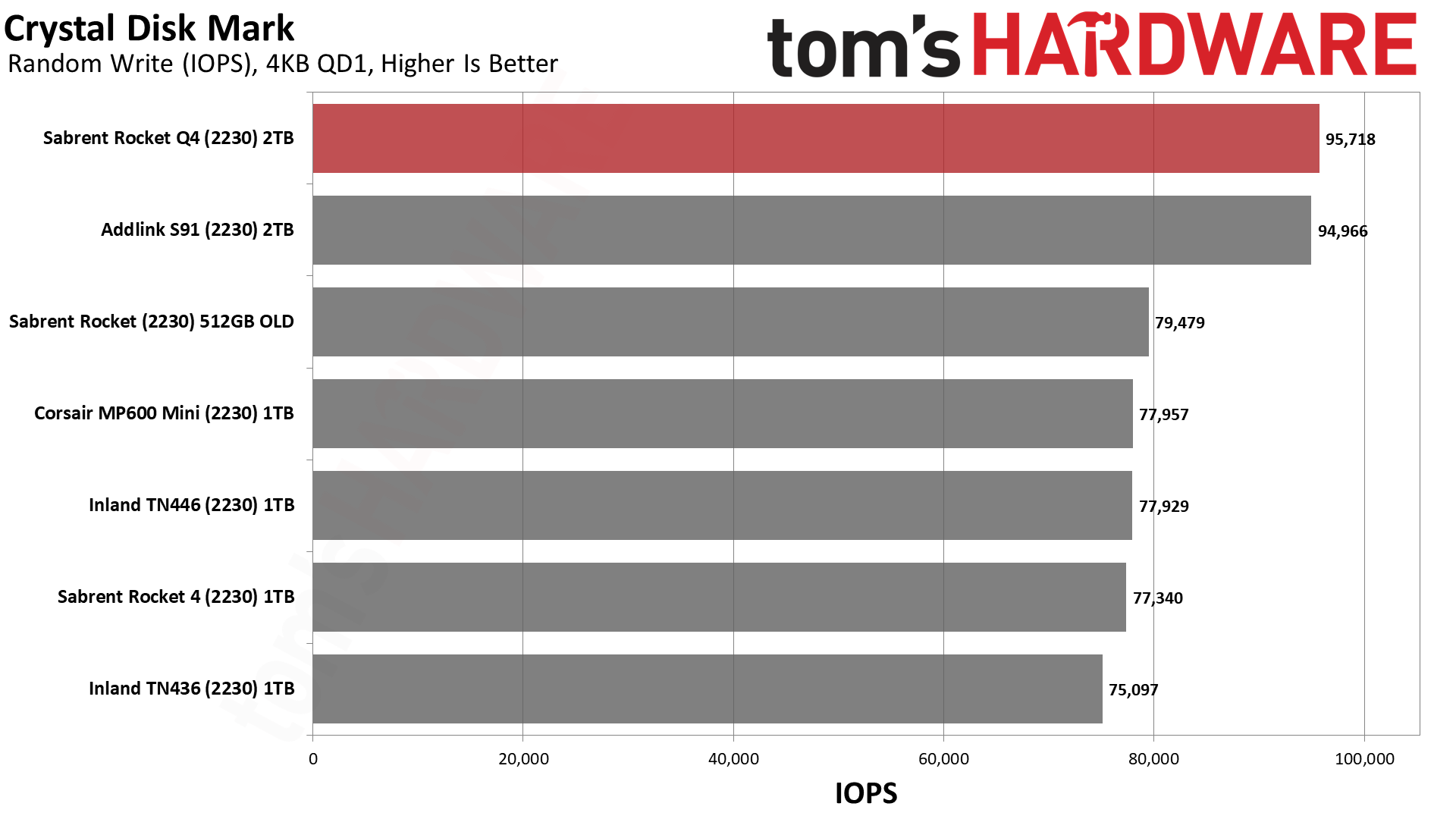

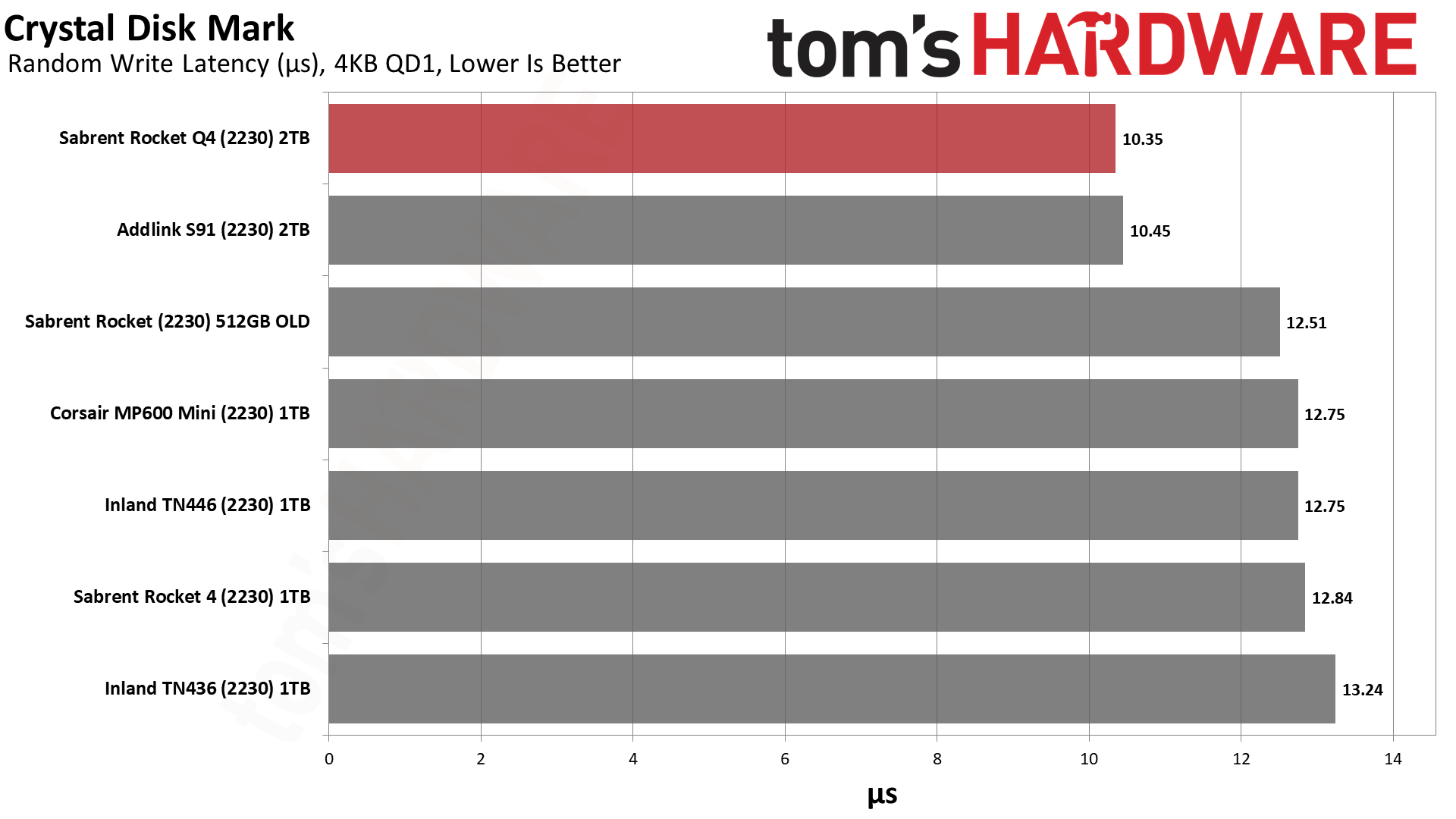
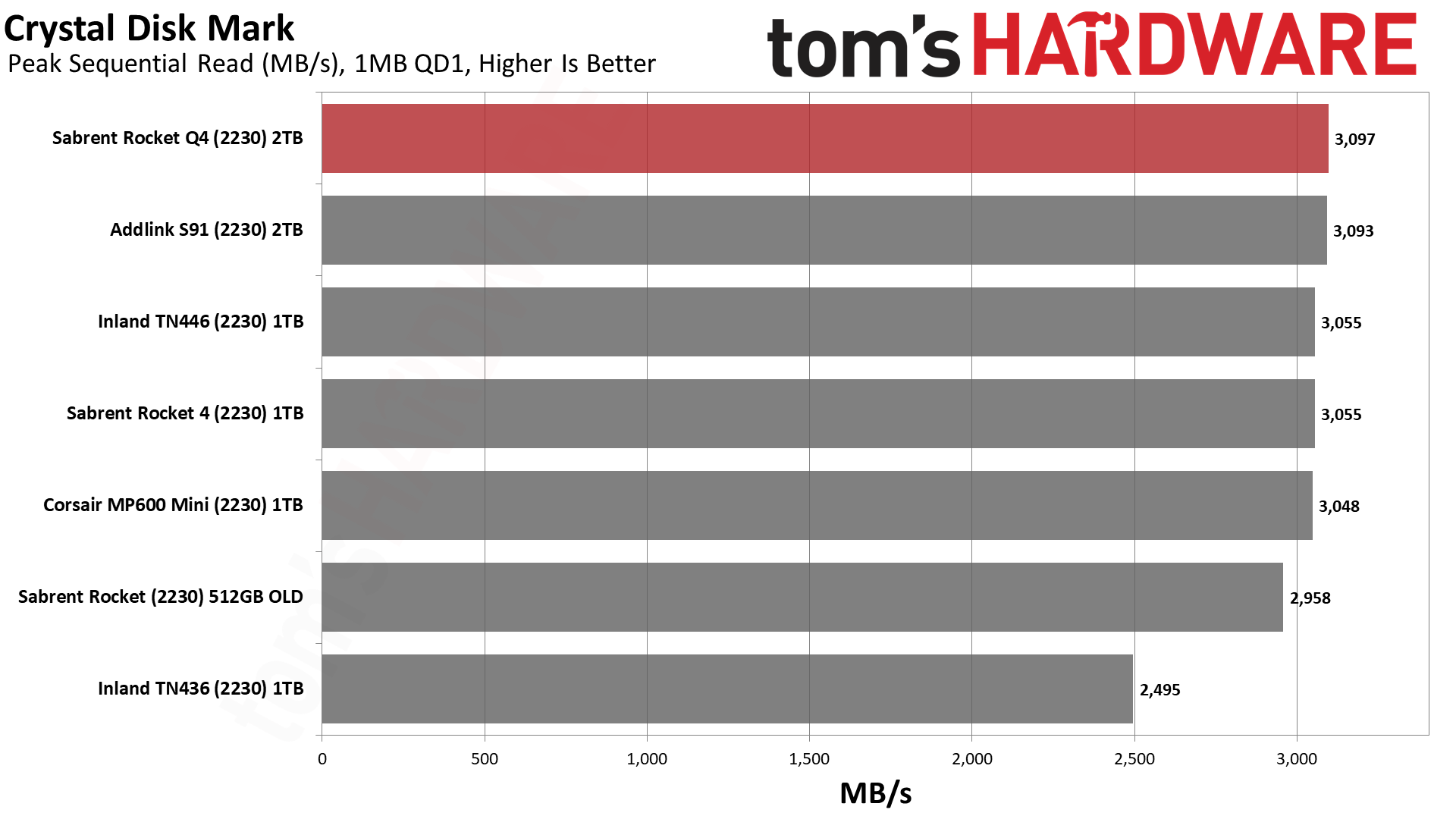
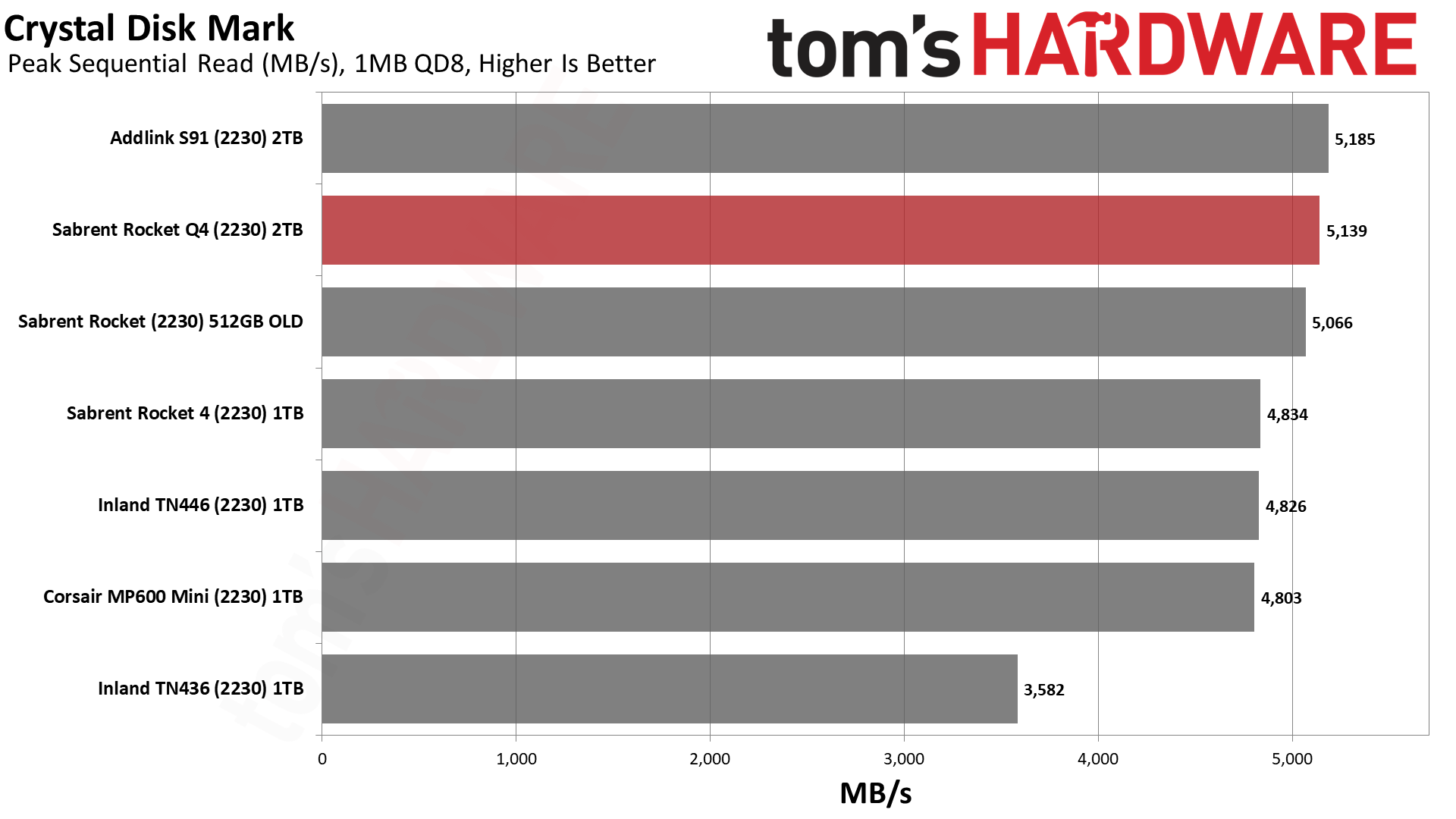

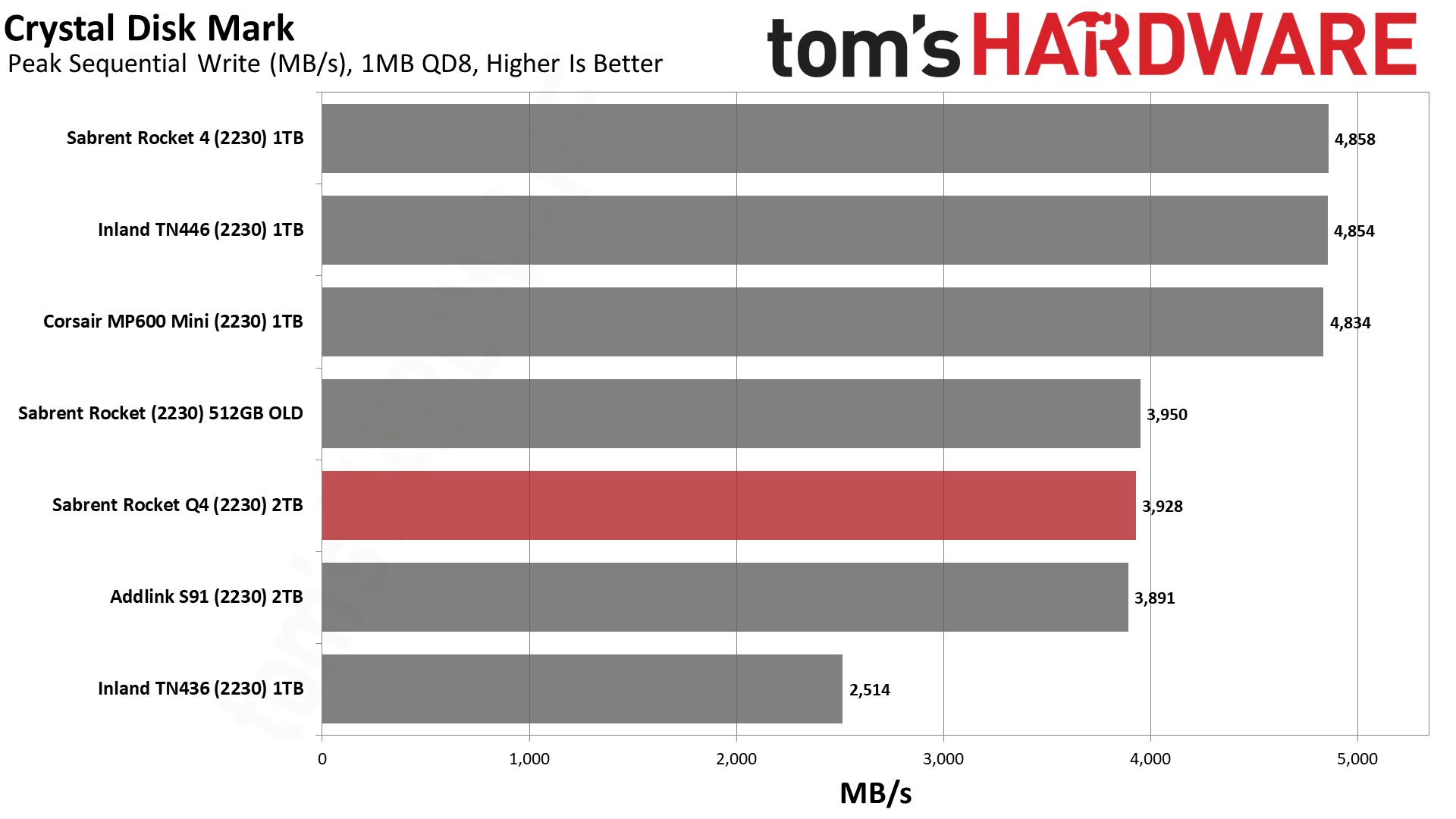
The Rocket Q4 2230 performs very well in ATTO. This is to be expected, as Phison SSD controllers usually do. It’s easy to see here how much the older TN436, a Kioxia BG5 clone with hardware used by many knock-off brands, falls behind.
The Rocket Q4 2230 performs ably with sequential workloads in CrystalDiskMark (CDM), too, being effectively at or near the top for reads, and both read and write workloads when restricted to PCIe 3.0. Even though it and the S91 have twice the capacity, the amount of dies and internal interleaving is the same as the 1TB TLC drives.
However, the QLC drives drop behind when it comes to write workloads with a PCIe 4.0 interface, despite all drives writing in pSLC mode. Writing to a QLC drive has more overhead as the block size is larger, there’s a bigger capacity ratio for pSLC, and native write speeds are significantly slower. For this reason, reducing the maximum write speeds even in pSLC mode can be wise, particularly as data might remain in pSLC longer to benefit reads, as QLC also has higher read latency. These drives also push up to the limits of the bus, with writes always hitting a wall before reads - due to more overhead, for one - which can hinder QLC more than TLC.
The longer read latency or time to read (tR) of the QLC flash is made evident through the CDM 4KB random read results. The Rocket Q4 2230’s latency is significantly higher than the Rocket 2230’s. 4KB write latency or time to program (tPROG) is much better, which we’ve seen before with Micron’s 176-Layer QLC. Under PCIe 4.0, the peak IOPS - however unrealistic a workload - will be lower for QLC, but the faster 4K writes can feel snappier in very rare cases.
PC Sustained Write Performance and Cache Recovery
Official write specifications are only part of the performance picture. Most SSDs implement a write cache, which is a fast area of (usually) pseudo-SLC programmed flash that absorbs incoming data. Sustained write speeds can suffer tremendously once the workload spills outside of the cache and into the "native" TLC or QLC flash.
We use Iometer to hammer the SSD with sequential writes for 15 minutes to measure both the size of the write cache and performance after the cache is saturated. We also monitor cache recovery via multiple idle rounds.
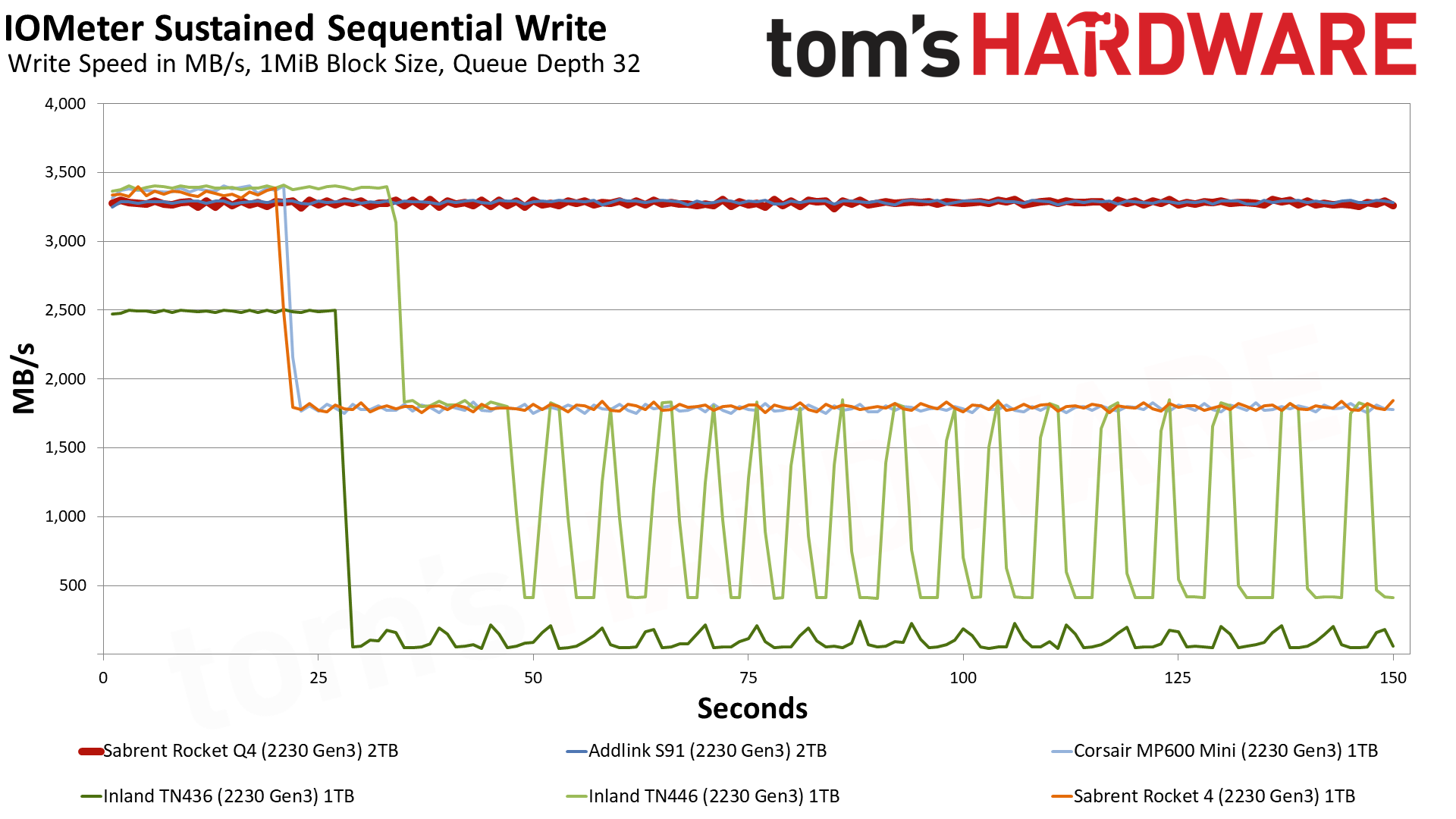



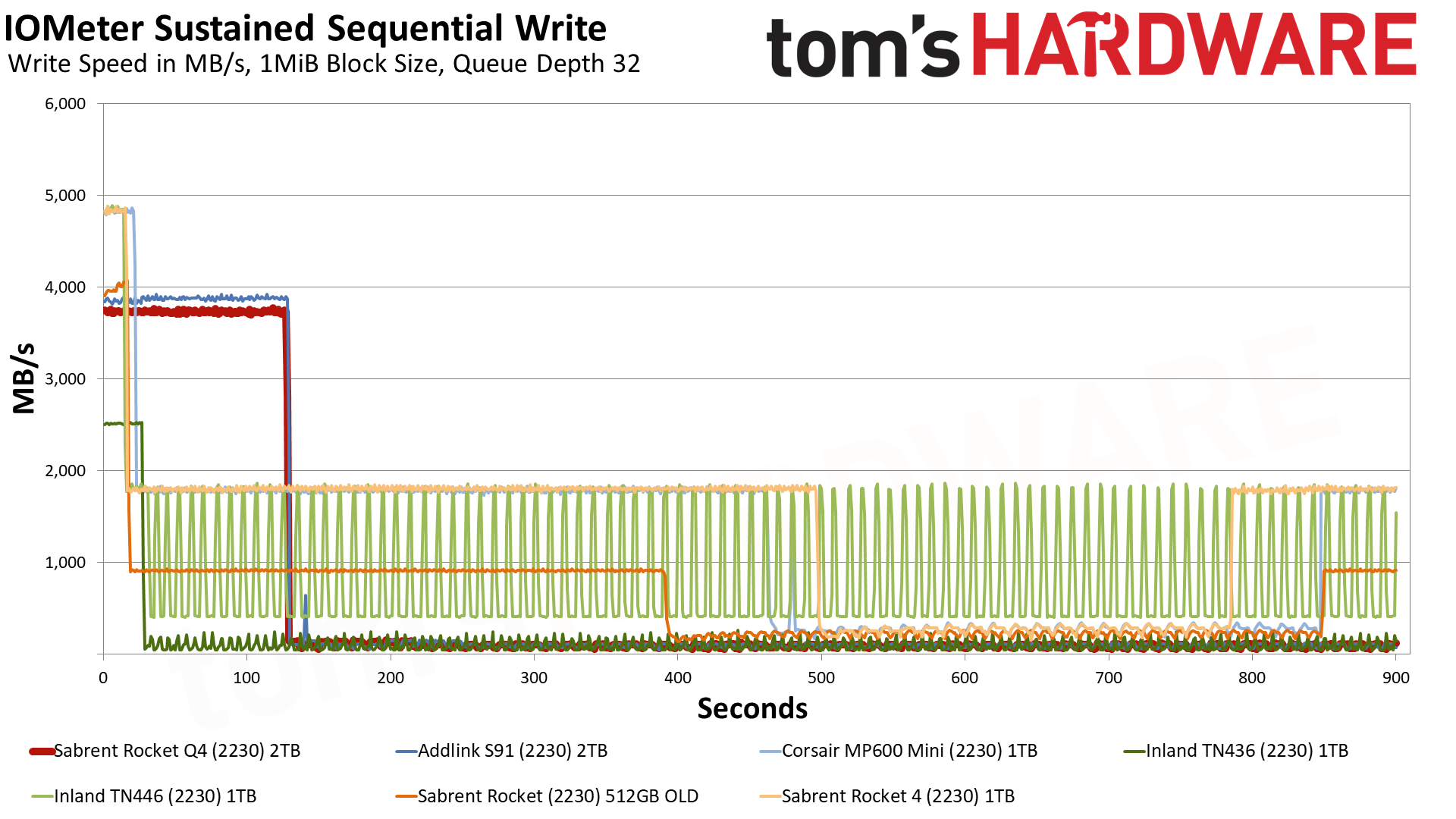

Regardless of the PCIe mode, the Rocket Q4 2230 writes the entirety of its free QLC as pSLC, which is shown by the >500GB cache. The folding to the QLC state after this is very slow, on the order of 100 MB/s during steady state conditions. Not that we necessarily see better things with all TLC flash, as the BiCS on the TN436 is quite inconsistent.
As shown here, write performance will be a factor for you as a buyer because upgrading an embedded device is usually followed by a lot of data writes - imaging/cloning, lots of downloads and installations, and usually a good deal of benchmarking, too. These drives will all eventually recover to pSLC mode. Writes become more consistent after this initial phase, and so the slower native flash modes are less critical. The pSLC cache will shrink with drive usage, but even at 75% full, the Q4 2230 will have at least 125GB of pSLC, which is more than enough.
Power Consumption and Temperature
We use the Quarch HD Programmable Power Module to gain a deeper understanding of power characteristics. Idle power consumption is an important aspect to consider, especially if you're looking for a laptop upgrade as even the best ultrabooks can have mediocre storage.
Some SSDs can consume watts of power at idle while better-suited ones sip just milliwatts. Average workload power consumption and max consumption are two other aspects of power consumption, but performance-per-watt is more important. A drive might consume more power during any given workload, but accomplishing a task faster allows the drive to drop into an idle state more quickly, ultimately saving energy.
For temperature recording we currently poll the drive’s primary composite sensor during testing with a 24C ambient.

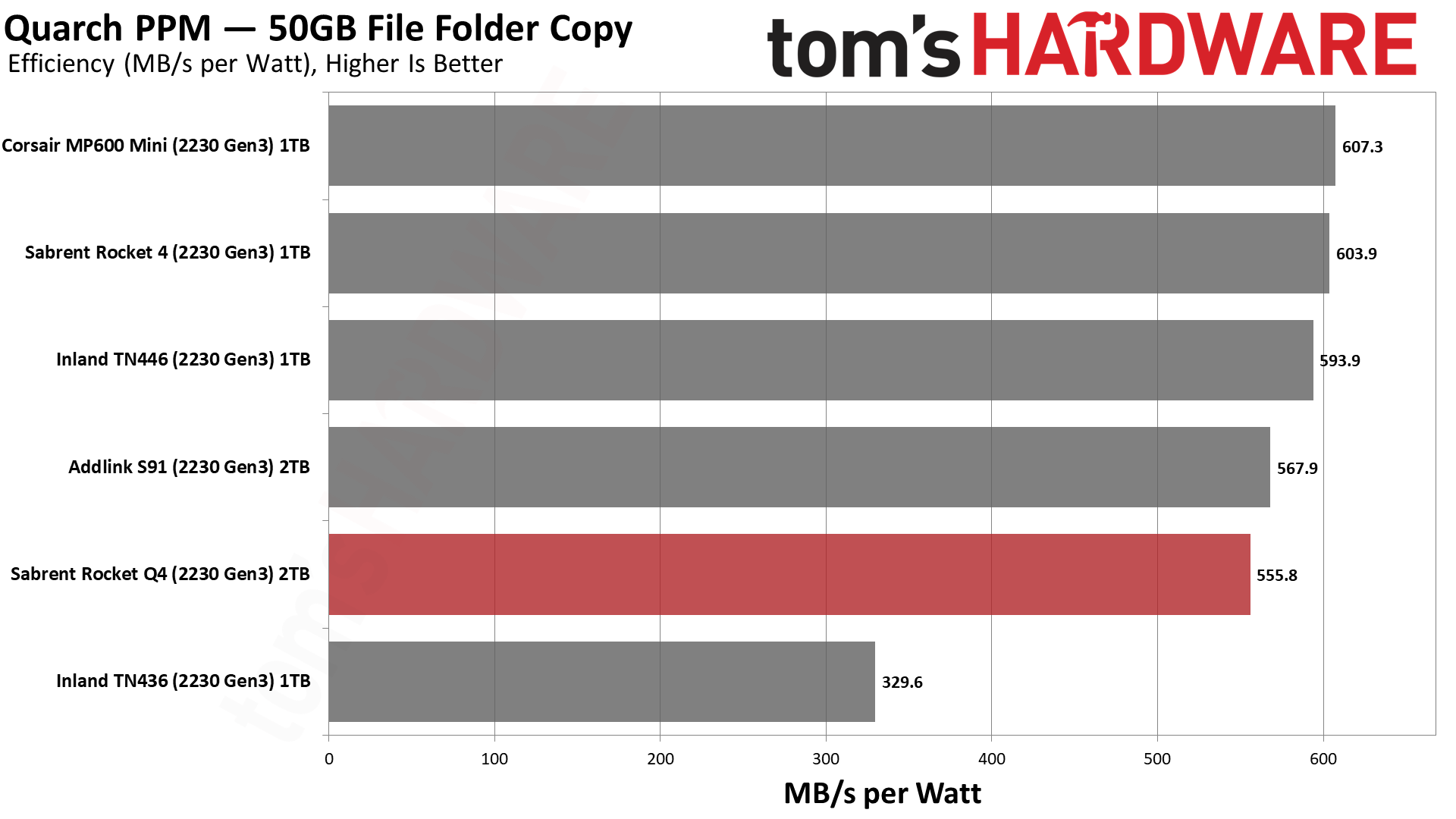
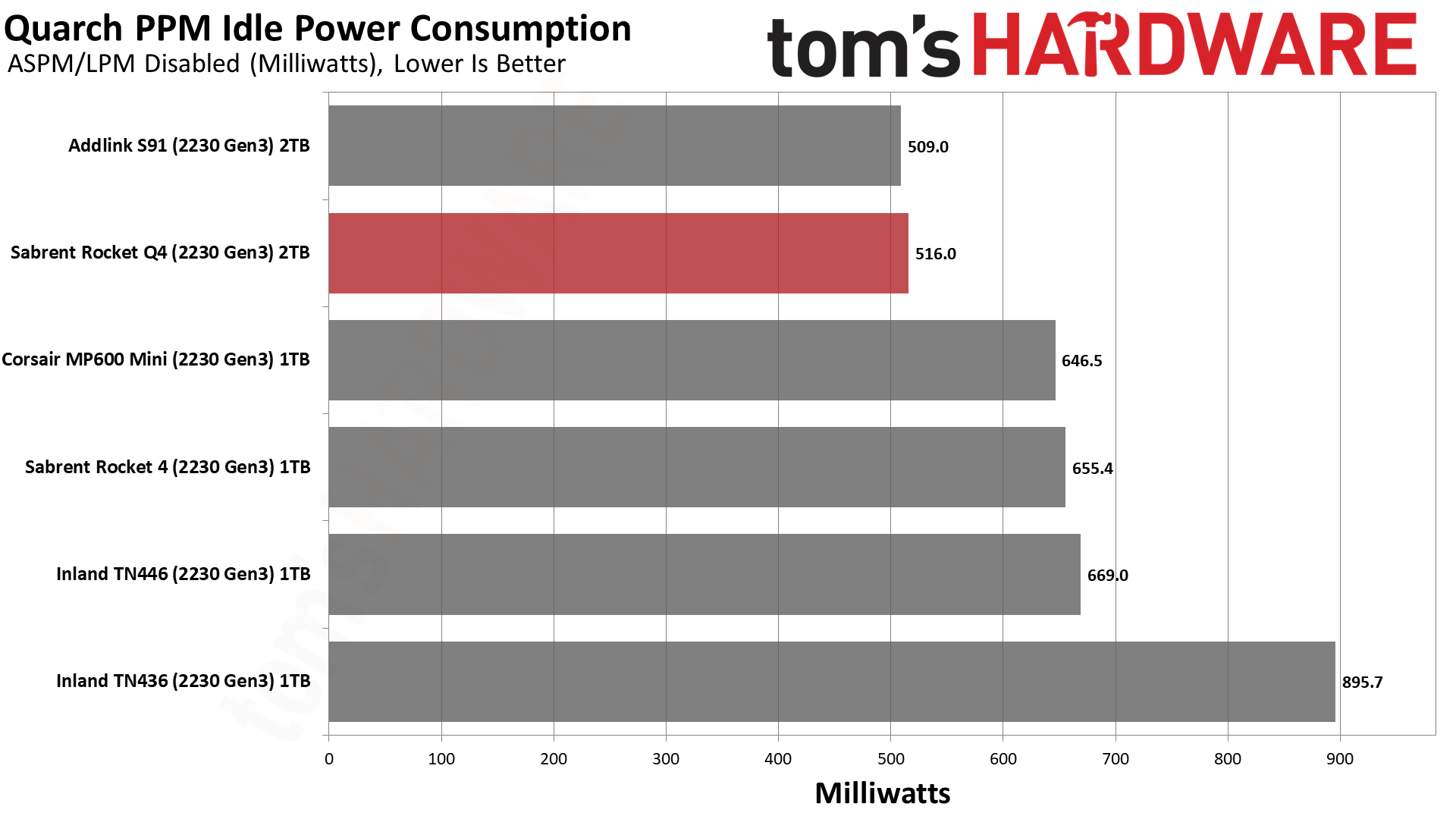

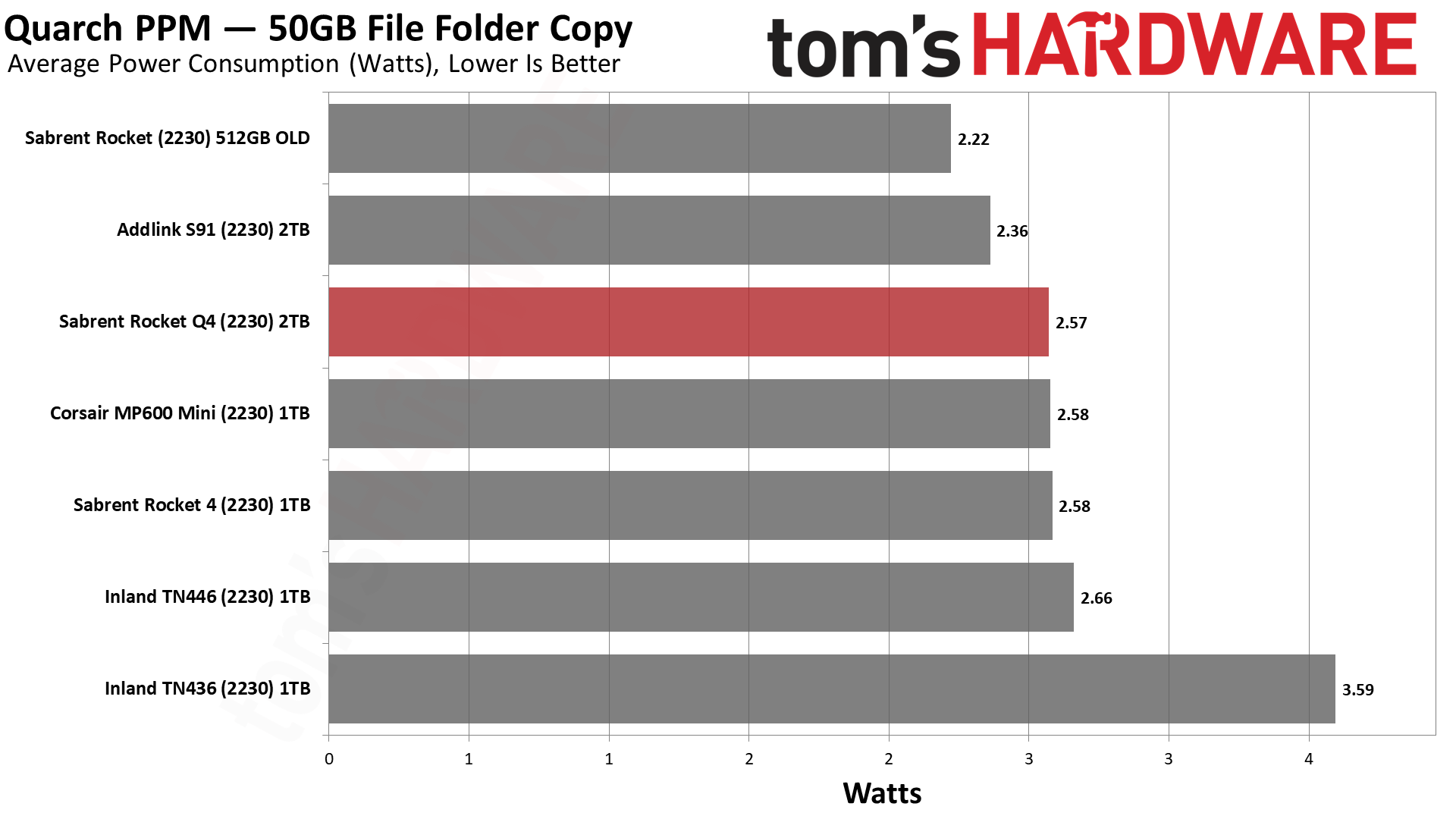
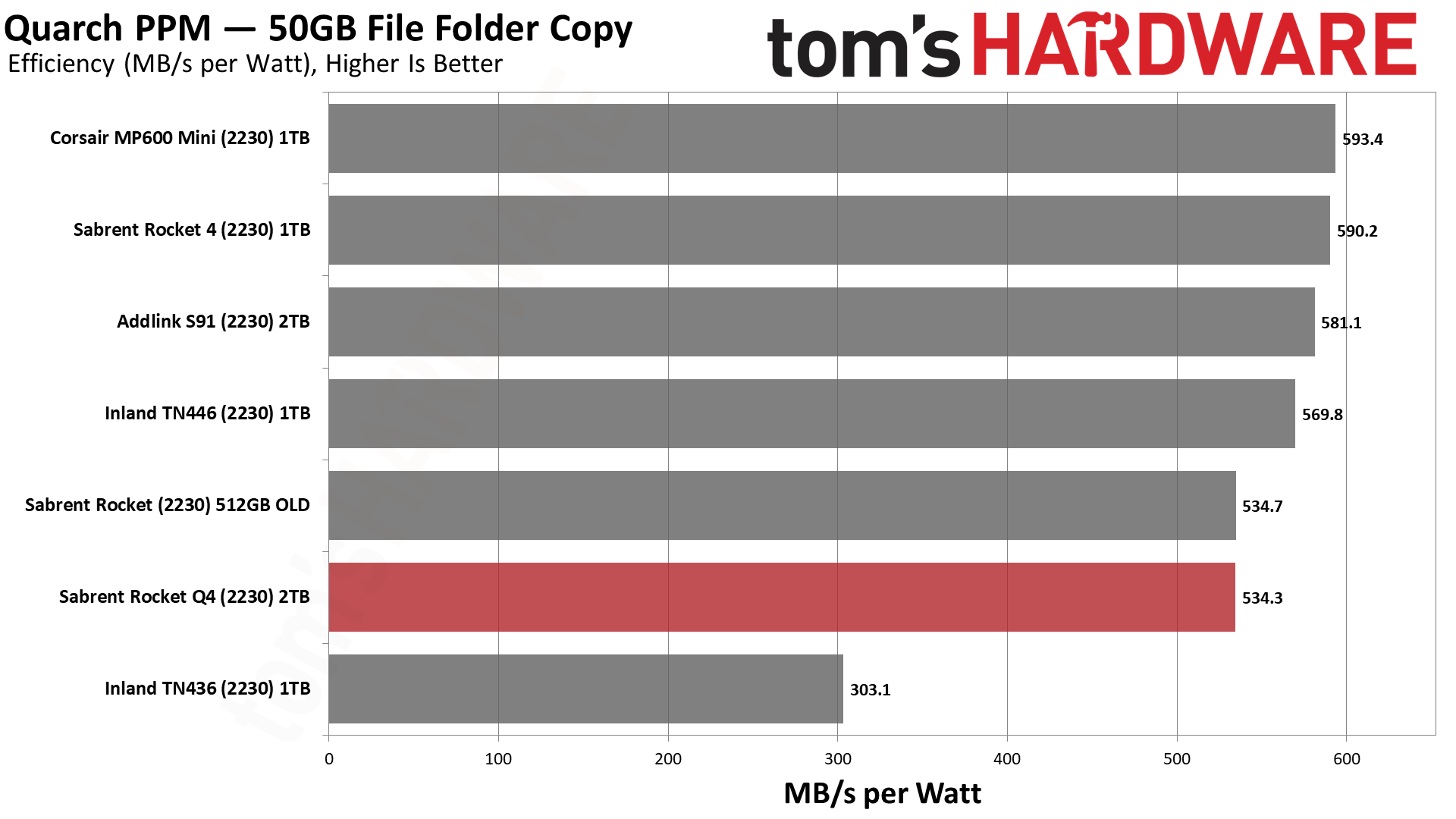
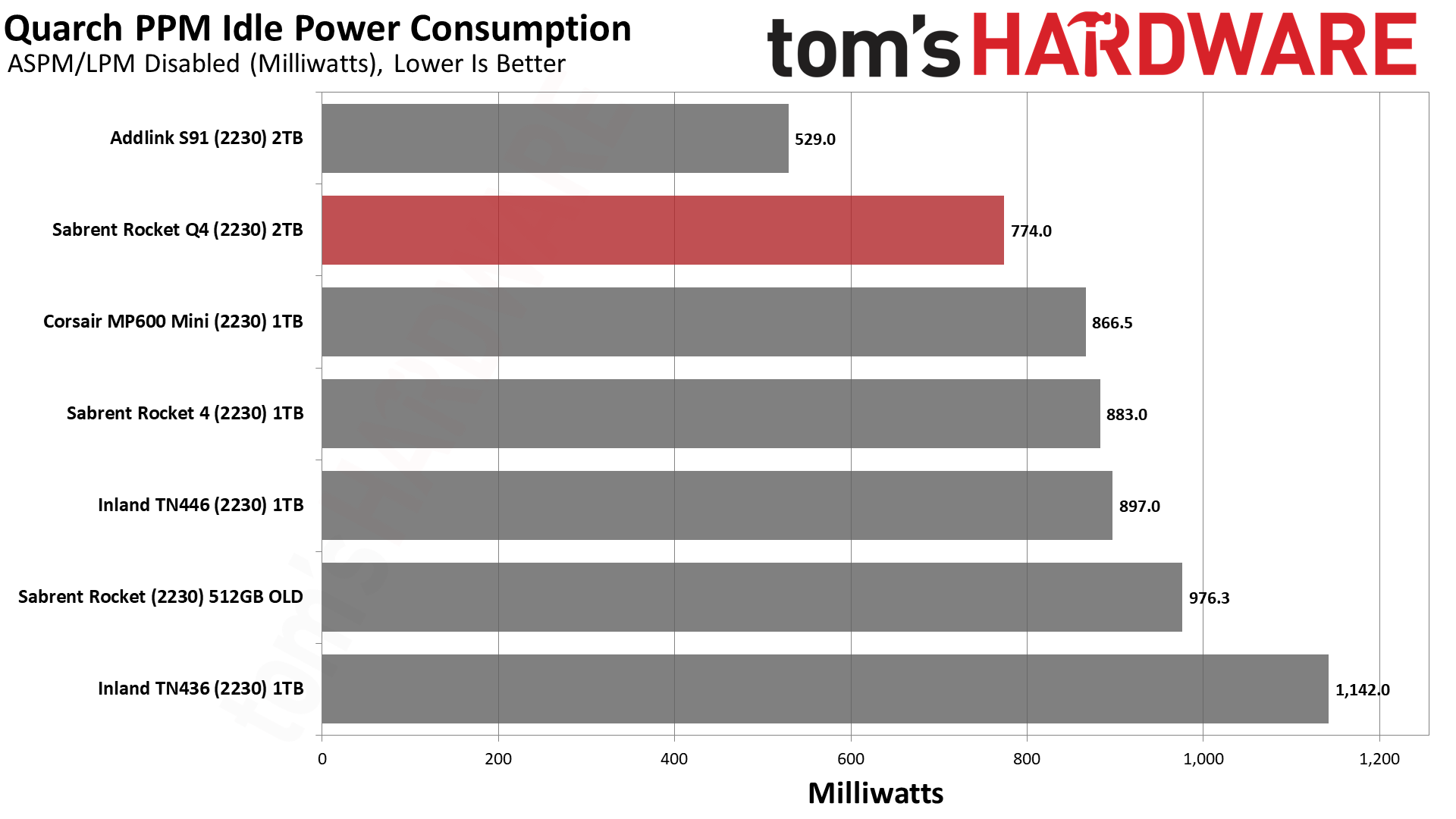
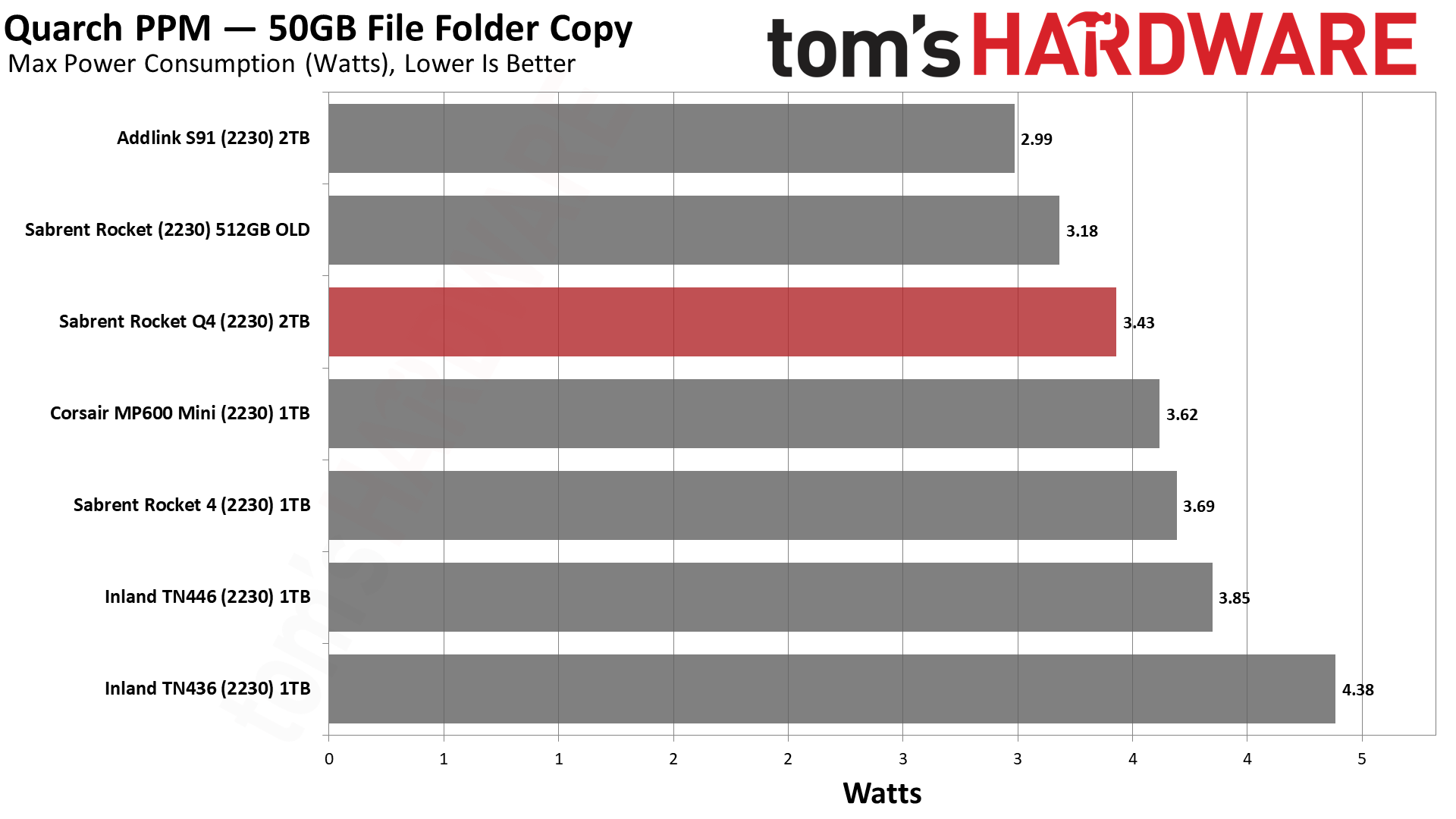
The Rocket Q4 2230 is very efficient, although not quite as efficient as its peers. However, the TLC drives are only 1TB. At 2TB, they could paradoxically be either more or less efficient. If utilizing the same density dies, theoretically, as you can’t do that with a single-sided M.2 2230 SSD, the increased overhead may lower efficiency. If using denser dies, as does the 2TB SN770, efficiency can increase because you have the same number of dies to engage but with more addresses per die.
This is not “free” because latency gets worse. Still, it does suggest that Micron’s 232-Layer TLC could probably provide for the best, no-compromise 2TB M.2 2230 drive, as the SN740’s BiCS5 lacks any CMOS under Array (CuA) technology and is already generationally behind Micron’s 176-Layer flash. That’s not to say WD hasn’t done amazing things with the flash, but embedded devices benefit from newer technology more than usual which is obvious when looking at the TN436. The downside is that no QLC or PLC is dense enough for a 4TB drive in this space. We’ll also have to wait for a verdict on BiCS6.
Generally, we would expect BiCS5 to be less efficient than B47R. In our testing, these drives largely peak at 3-4W when something like the 2TB SN740 is rated for a peak of 6.3W, a substantial difference. Our 2TB SN770 reached a peak of 4.91W, which is noticeably less efficient at 1TB and 2TB. In practice, the difference probably isn’t massive as long as you have a newer controller, though - the TN436’s E19T is objectively much less efficient.
It is worth noting that the Rocket Q4 2230 pulls less power when idle than the TLC options, but in the Steam Deck or Ally, you should have the best power states available outside of any turbo modes. Still, there are cases where this could trickle, for example, if you like to really push the battery with full-on gaming. Still, even in this worst-case scenario, the Rocket Q4 2230 would only theoretically be a few percentage points of battery life better at most than something like the 2TB SN740.
As for temperature, it’s worth checking our Crucial P3 and Crucial P3 Plus reviews to get an idea of what to expect at PCIe 3.0 and 4.0, respectively. This is because the P3 and P3 Plus use the same hardware as the Rocket Q4 2230. As tested, the Rocket Q4 2230 did not throttle even at PCIe 4.0, although it did get up to 79C with sustained write testing. Normal desktop use was well below throttling, especially in PCIe 3.0 mode.
Its higher peak temperature than the P3 and P3 Plus likely boils down to the shorter form factor, with the controller and flash being closer together. The drive is bound to run hotter when installed in an embedded device, but thankfully sustained writes are not common. We would suggest a careful installation; if possible, adding thermal padding could help. The Rocket Q4 2230 does have the heatspreader label, which helps a small amount, although, as mentioned before, it requires adjustment with the Deck’s SSD EMI shield.
Test Bench and Testing Notes
| CPU | Intel Core i9-12900K |
| Motherboard | Asus ROG Maximus Z790 Hero |
| Memory | 2x16GB G.Skill DDR5-5600 CL28 |
| Graphics | Intel Iris Xe UHD Graphics 770 |
| CPU Cooling | Enermax Aquafusion 240 |
| Case | Cooler Master TD500 Mesh V2 |
| Power Supply | Cooler Master V850 i Gold |
| OS Storage | Sabrent Rocket 4 Plus 2TB |
| Operating System | Windows 11 Pro |
We use an Alder Lake platform with most background applications such as indexing, Windows updates, and anti-virus disabled in the OS to reduce run-to-run variability. Each SSD is prefilled to 50% capacity and tested as a secondary device. Unless noted, we use active cooling for all SSDs.
Bottom Line
The Sabrent Rocket Q4 2230 is not a bad SSD, although that’s to be expected as it’s built on the well-performing Phison E21T SSD controller. It doesn’t use TLC flash, but its QLC is some of the best. It’s a worthwhile trade-off to get 2TB in a single-sided M.2 2230 SSD. It wasn't easy to find M.2 2230 drives in retail for a long time, but now multiple drives have sprung up. For example, many Kioxia BG5 clones are sold by random companies on Amazon.
There will be more and better options in the future, but for now, the Rocket Q4 2230 is a quick and easy way to get a lot of fast internal storage, even when it’s not the less expensive option.
Many embedded or portable devices only run at PCIe 3.0, including the very popular Steam Deck. In this mode, PCIe 4.0 SSDs run cooler and more efficiently and still perform excellently. The Rocket Q4 2230 is perfect here, as it only really falls behind with peak performance when compared to PCIe 4.0 mode. Since it’s QLC-based, it does suffer with sustained performance, particularly as it has a large pSLC cache which leads to a significant drop, but thankfully this is something that is rarely a problem with devices like the Steam Deck. With how things are right now, the Rocket Q4 2230 is a good choice if it’s priced right.
There are, of course, other options, such as the Addlink S91, which uses effectively the same hardware. There’s also the TLC-based WD SN740, although this drive was not widely available in retail until Framework picked it up. The Micron 2400 is in similar straits, although it was available earlier and in more places, and now finds a nice retail home with iFixit. The 2TB Team MP44S is another option that has only been available as of mid-July.
All of these drives will do as well as the Rocket Q4 2230 if you’re looking for a 2TB solution, but the level of support will vary. However, we caution that an M.2 2230 SSD purchase should be made carefully and with some consideration — be wary of cheap no-name drives available on AliExpress, eBay, and other marketplaces.
The Rocket Q4 2230 may also arrive with 1TB of capacity, but there’s a lot more competition there; it would have to be priced aggressively, and the market may not support that. A better option might be to wait until denser TLC allows for more 2TB retail alternatives. This would bring down the cost of the Rocket Q4 2230, which would be a good thing for the market. Older drives like the TN436 can’t hang, but future controllers could allow devices like the Ally to saturate PCIe 4.0 without additional downsides. The Rocket Q4 2230 is a safe bet right now, though, particularly as extra performance isn’t needed yet.
MORE: Best SSDs
MORE: Best External SSDs and Hard Drives
MORE: How We Test HDDs And SSDs
MORE: All SSD Content

Shane Downing is a Freelance Reviewer for Tom’s Hardware US, covering consumer storage hardware.
-
abufrejoval I guess the biggest question is: how do you ensure it's done steady-state processing before you turn the device off?Reply
These gaming decks spend plenty of time not being used, so time windows for such 'batch background' processing exists aplenty... except that you might not charge it immediately and that you'd have probably turned it off, too.
I guess even if the OS isn't really needed running, the OS will decide to put the SSD into sleep state and there is very little the SSD can do without risking to have its juice cut off, should it try to refuse.
So you need to keep the console on after you've finished to enable the SLC->QLC transfer and the erasure block optimizations to happen.
And in fact I guess there isn't even a proper protocol for the SSD to tell the host that it's finished doing housekeeping and now wouldn't mind being turned off.... or is NVMe a lot smarter than I give it credit for? -
evdjj3j The ratings on this site make no sense whatsoever. Jerrad claims that 3 1/2 stars on his reviews is a a C yet this review with 3 stars claims in the summary that this drive is a good buy.Reply -
JarredWaltonGPU Reply
A mediocre product at a good price might still be a good buy, particularly for a drive going in a Steam Deck. Not that this is a "good" price, but 2TB 2230 drives aren't really cheap right now. Also: Different people, different takes. The text is far more important than the score, in my view.evdjj3j said:The ratings on this site make no sense whatsoever. Jerrad claims that 3 1/2 stars on his reviews is a a C yet this review with 3 stars claims in the summary that this drive is a good buy. -
JarredWaltonGPU Reply
If you're still copying files, in Windows, you'd see the dialog still open. For Linux, you'd have something similar. On a Steam Deck, the only thing you'd likely be doing is downloading and installing a game, which can also be interrupted. This is the whole purpose of the shutdown procedure in modern OSes, giving the OS time to clean things up before turning off.abufrejoval said:I guess the biggest question is: how do you ensure it's done steady-state processing before you turn the device off?
These gaming decks spend plenty of time not being used, so time windows for such 'batch background' processing exists aplenty... except that you might not charge it immediately and that you'd have probably turned it off, too.
I guess even if the OS isn't really needed running, the OS will decide to put the SSD into sleep state and there is very little the SSD can do without risking to have its juice cut off, should it try to refuse.
So you need to keep the console on after you've finished to enable the SLC->QLC transfer and the erasure block optimizations to happen.
And in fact I guess there isn't even a proper protocol for the SSD to tell the host that it's finished doing housekeeping and now wouldn't mind being turned off.... or is NVMe a lot smarter than I give it credit for?
Powering off (via a hard switch) in the middle of doing anything can be bad. Most drives limit how much stuff sits in volatile storage (RAM caches) for exactly this reason. High-end drives would have a super capacitor to store power so that they can flush things from RAM to NAND in the event of a power loss. For consumer drives, it's possible, if you cycle the power in the middle of writes, to kill an SSD. Probably very unlikely, and it would depend on the model, but I know in the past I heard of this happening. -
abufrejoval Reply
Just to make sure we're on the same page: I am concerned that the usage pattern of a Steam deck or console will give your device very little time to move freshly written data from the SLC cache to permanent QLC storage.JarredWaltonGPU said:If you're still copying files, in Windows, you'd see the dialog still open. For Linux, you'd have something similar. On a Steam Deck, the only thing you'd likely be doing is downloading and installing a game, which can also be interrupted. This is the whole purpose of the shutdown procedure in modern OSes, giving the OS time to clean things up before turning off.
Powering off (via a hard switch) in the middle of doing anything can be bad. Most drives limit how much stuff sits in volatile storage (RAM caches) for exactly this reason. High-end drives would have a super capacitor to store power so that they can flush things from RAM to NAND in the event of a power loss. For consumer drives, it's possible, if you cycle the power in the middle of writes, to kill an SSD. Probably very unlikely, and it would depend on the model, but I know in the past I heard of this happening.
SSD firmware is a lot like a database transaction log, that needs some idle to empty properly.
Windows and Linux will see just a committed write, turning off the device won't loose you any data, it might just not have the opportunity to do the house-keeping and the SLC cache will remain permanently filled while the drive has to bypass it for new data resulting in HDD class write speeds.
It all depends on just how eager the SSD is about evicting the SLC cache and how high your update rate is. If your Internet is well below 1Gbit, there is little risk it will overflow the SLC cache, if your Steam deck is receiving updates from your gaming PC NBase-T rates and SLC eviction is very lazy, things could be different.
At 2TB for your Steam stash, at least you won't have to swap games in and out as often, which signficantly helps to lessen the write burden.
I've never liked the unpredictability of QLC or in fact SLC caches on principle. I can't say that I've been badly hit by it either, but that's a small surprise, since I never knowingly bought any QLC devices: I went from SLC to MLC quickly but took my sweet time to switch from MLC to TLC, but then SSDs were still caching not holding entire Steam collections.
But I've often wondered if SSDs that are only used in a very bursty manner (top load or off) might accumulate write amplification debt by their usage patterns. Modern flash drives need idle time to do housekeeping, including internal patrol reads to keep blocks from decaying beyond their ECC thresholds.
Desktops and even office notebooks provide tons of idle, a Steam deck perhaps much less so.
You could investigate, and make that an article: wouldn't that be fun? -
JarredWaltonGPU Reply
So, the pseuso-SLC cache is still non-volatile. Even if you filled it up with sustained writes, and then immediately told the PC to shutdown, all that data is still there and "safe." The SSD would just work to flush out the pSLC cache to QLC storage once it's powered back up and basically idle. At least, that's my understanding of things, so the pSLC isn't a bad approach at all.abufrejoval said:Just to make sure we're on the same page: I am concerned that the usage pattern of a Steam deck or console will give your device very little time to move freshly written data from the SLC cache to permanent QLC storage.
SSD firmware is a lot like a database transaction log, that needs some idle to empty properly.
Windows and Linux will see just a committed write, turning off the device won't loose you any data, it might just not have the opportunity to do the house-keeping and the SLC cache will remain permanently filled while the drive has to bypass it for new data resulting in HDD class write speeds.
It all depends on just how eager the SSD is about evicting the SLC cache and how high your update rate is. If your Internet is well below 1Gbit, there is little risk it will overflow the SLC cache, if your Steam deck is receiving updates from your gaming PC NBase-T rates and SLC eviction is very lazy, things could be different.
At 2TB for your Steam stash, at least you won't have to swap games in and out as often, which significantly helps to lessen the write burden.
I've never liked the unpredictability of QLC or in fact SLC caches on principle. I can't say that I've been badly hit by it either, but that's a small surprise, since I never knowingly bought any QLC devices: I went from SLC to MLC quickly but took my sweet time to switch from MLC to TLC, but then SSDs were still caching not holding entire Steam collections.
But I've often wondered if SSDs that are only used in a very bursty manner (top load or off) might accumulate write amplification debt by their usage patterns. Modern flash drives need idle time to do housekeeping, including internal patrol reads to keep blocks from decaying beyond their ECC thresholds.
Desktops and even office notebooks provide tons of idle, a Steam deck perhaps much less so.
You could investigate, and make that an article: wouldn't that be fun?
Note that with a 2TB SSD, the pSLC cache could be up to 500GB in size for a completely empty drive. So, if you could do sustained writes at max speed and fill that up, and then had to drain it at ~100 MB/s, it could take over 1.38 hours just to empty the pSLC to QLC. LOL. (Related: The drives take a while to recover in our Windows testing, unless you just wipe/format them.)
For the Steam Deck, the only way you'd really exceed even the reduced SSD write speed is if you had a wired connection. In my experience at least, you're otherwise limited by the Wi-Fi. It's a Wi-Fi 6 device (802.11ac 2x2 to be specific), which means best-case it has a theoretical 866 Mbps throughput. Except, you will NEVER see that in the real-world, even in ideal scenarios.
Basically, Wi-Fi 6 2x2 speeds will usually max out at maybe 550 Mbps, and if you have anything else happening on the network you'll probably get more like 350 Mbps. I have an 802.11ac 2x2 router for my house, and download speeds on the Steam Deck topped out at around 270–300 Mbps consistently. I get faster than that on some laptops with similar adapters, so it's likely the Steam Deck hardware that's slowing things down.
So if you have a hypothetical 200GB game download going, best-case it's writing to your SSD at maybe 60 MB/s, and very possibly closer to 35 MB/s. Even the worst QLC drives can basically do that all day without problems. Heck, even hard drives could do that, but HDDs are worse for power, size, and other performance aspects since they have that whole constantly spinning disk thing going on.
It would be interesting to try testing this. Like, a decent SSD and controller should write initially to the pSLC cache, but if it's only at ~40 MB/s, the cache can then be immediately flushed to QLC and would perhaps never fill up (until the SSD is completely full). The problem is that writing even 100GB of data at 40 MB/s takes a while, about 40 minutes. I guess that would be the question: if write speeds are slow, like sub-100 MB/s, do the SSDs even use their pSLC caches, or do they just write straight to TLC/QLC NAND? -
abufrejoval Reply
Yup, it's at that point when you want to start reading the controller's source code.JarredWaltonGPU said:So, the pseuso-SLC cache is still non-volatile. Even if you filled it up with sustained writes, and then immediately told the PC to shutdown, all that data is still there and "safe." The SSD would just work to flush out the pSLC cache to QLC storage once it's powered back up and basically idle. At least, that's my understanding of things, so the pSLC isn't a bad approach at all.
Note that with a 2TB SSD, the pSLC cache could be up to 500GB in size for a completely empty drive. So, if you could do sustained writes at max speed and fill that up, and then had to drain it at ~100 MB/s, it could take over 1.38 hours just to empty the pSLC to QLC. LOL. (Related: The drives take a while to recover in our Windows testing, unless you just wipe/format them.)
For the Steam Deck, the only way you'd really exceed even the reduced SSD write speed is if you had a wired connection. In my experience at least, you're otherwise limited by the Wi-Fi. It's a Wi-Fi 6 device (802.11ac 2x2 to be specific), which means best-case it has a theoretical 866 Mbps throughput. Except, you will NEVER see that in the real-world, even in ideal scenarios.
Basically, Wi-Fi 6 2x2 speeds will usually max out at maybe 550 Mbps, and if you have anything else happening on the network you'll probably get more like 350 Mbps. I have an 802.11ac 2x2 router for my house, and download speeds on the Steam Deck topped out at around 270–300 Mbps consistently. I get faster than that on some laptops with similar adapters, so it's likely the Steam Deck hardware that's slowing things down.
So if you have a hypothetical 200GB game download going, best-case it's writing to your SSD at maybe 60 MB/s, and very possibly closer to 35 MB/s. Even the worst QLC drives can basically do that all day without problems. Heck, even hard drives could do that, but HDDs are worse for power, size, and other performance aspects since they have that whole constantly spinning disk thing going on.
It would be interesting to try testing this. Like, a decent SSD and controller should write initially to the pSLC cache, but if it's only at ~40 MB/s, the cache can then be immediately flushed to QLC and would perhaps never fill up (until the SSD is completely full). The problem is that writing even 100GB of data at 40 MB/s takes a while, about 40 minutes. I guess that would be the question: if write speeds are slow, like sub-100 MB/s, do the SSDs even use their pSLC caches, or do they just write straight to TLC/QLC NAND?
But then perhaps, you'd never trust it with your data again, when you see how badly even firmware can be written =:-O
And when the firmware has to deal with things like host buffers, that require interaction with host firmware that could be buggy, too, and simply sprinkle your most critical data structures with random bits, you wonder if these firmware engineers might have burn out or a drinking problem, especially since these junior guys only get to work on the cheaper entry level products, which are much harder to handle than when you've got everything fully under your own control.
My very first SSDs were FusionIO drives, which basically operated in host-buffer mode and a host side firmware, while the FPGA on the drive only did the lowest level signal processing and basic chores. It let me appreciate the complexity that has now transitioned into the drives themselves, which run a software stack which has your average VAX cluster look primitive by comparison.
So I am eagerly awaiting your results and suggest you dock the Steam deck, use a 2.5 Gbit USB Ethernet dongle and let Steam stream from a big desktop locally.
Of course you could always just run 'fio' and see what happens.
And you obviously don't need to test this on a Steam deck, any M.2 slot in a PC will do.. -
abufrejoval In the older days, I used to worry a lot about keeping enough spare area around to ensure that in absence of TRIM support my SSDs wouldn't start reflashing entire erase blocks for every 512 byte sector written.Reply
These days I just keep running my manual TRIMs when I do major updates and most of my SSDs never go near the 90% mark anyway before I expand or reallocate: prices below €50/TB evict quite a lot of lesser capacity drives natuerally, which interestingly have never gone near 90% remaining life in all those years.
But... I've also had some very old Android tablets die on storage that seemed to reprogram flash at EEPROM speeds, never giving up ...before I did.
Steam caches are a bit special, because there are actually non-critical data: if data actually were to get corrupted, all you need is wait for it to download from somewhere else.
So you tend to get messy with it, fill your storage more recklessly. In the case of my kids it's always near 100% which has me banging my head and my kids shrugging ('never given me a problem, but I need more space..')
What I really want is a local shared Steam cache on my 10Gbit LAN, only one copy of every game in a houshold with nearly 10 Steam devices of various kinds.
But it turns out Windows really, really sucks at opening hundreds of thousands of little files when I open my favorite game, which is ARK survival evolved. And it sucks much, much worse, when you do that over the network.
I had ARK running once on Linux: It loaded ARK faster from a hard disk than Windows loaded it from NVMe...
The graphics were another issue and I love the game for its eye candy. -
JarredWaltonGPU Reply
I had a 1TB Steam / etc. caching system set up at one point, back in the day. But now that I have a gigabit internet connection, it's not really useful. I do remember I had issues where often it would download the same file multiple times because of SSL or something, and I think that was also why I stopped bothering. Well, that plus fast internet plus no data cap. I am still just running gigabit Ethernet, as that's what all of my PCs support. I think one or two have 10GbE ports, but trying to rewire plus the cost of the new router has me just ignoring it for now. Maybe in another five years or so I'll finally be convinced to make the switch!abufrejoval said:In the older days, I used to worry a lot about keeping enough spare area around to ensure that in absence of TRIM support my SSDs wouldn't start reflashing entire erase blocks for every 512 byte sector written.
These days I just keep running my manual TRIMs when I do major updates and most of my SSDs never go near the 90% mark anyway before I expand or reallocate: prices below €50/TB evict quite a lot of lesser capacity drives natuerally, which interestingly have never gone near 90% remaining life in all those years.
But... I've also had some very old Android tablets die on storage that seemed to reprogram flash at EEPROM speeds, never giving up ...before I did.
Steam caches are a bit special, because there are actually non-critical data: if data actually were to get corrupted, all you need is wait for it to download from somewhere else.
So you tend to get messy with it, fill your storage more recklessly. In the case of my kids it's always near 100% which has me banging my head and my kids shrugging ('never given me a problem, but I need more space..')
What I really want is a local shared Steam cache on my 10Gbit LAN, only one copy of every game in a houshold with nearly 10 Steam devices of various kinds.
But it turns out Windows really, really sucks at opening hundreds of thousands of little files when I open my favorite game, which is ARK survival evolved. And it sucks much, much worse, when you do that over the network.
I had ARK running once on Linux: It loaded ARK faster from a hard disk than Windows loaded it from NVMe...
The graphics were another issue and I love the game for its eye candy. -
saunupe1911 I hate Sabrent. Their support absolutely sucks!!!!!! I've had 3...I repeat...3 Rocket 4 NVME die on me within 3 years. One of them was their dang replacement. Meanwhile I've had Samsung and PNY drives last even longer!!!!!!!!!!!!!!!!!Reply
Stop promoting these pissy products
